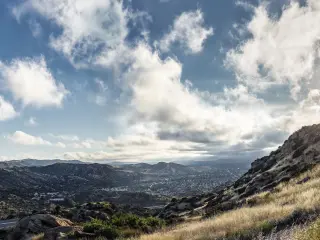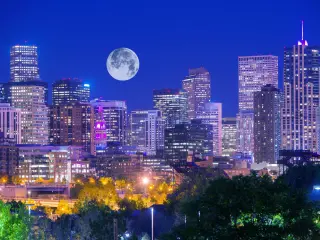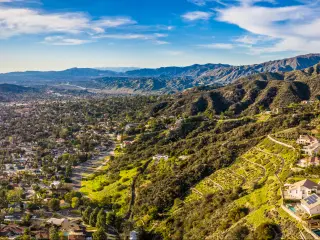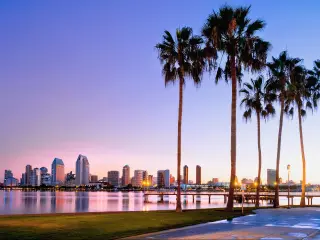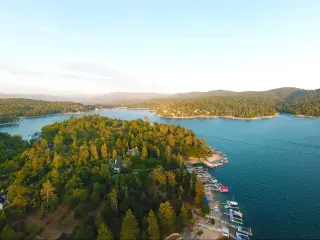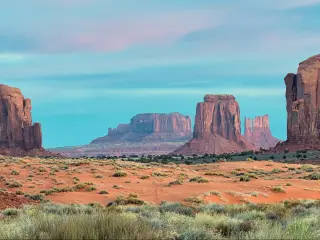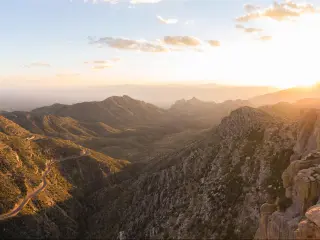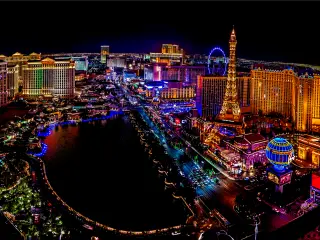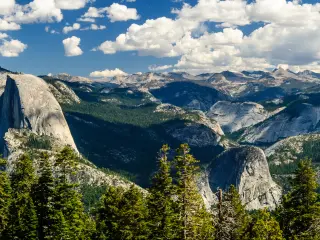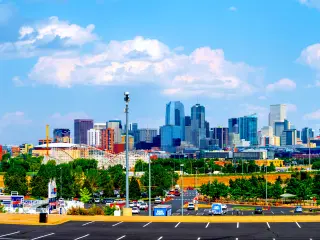30 Best National Parks Near San Diego
If you're in the beautiful coastal city of San Diego and are itching for an adventure, then you are in luck! You are ideally positioned to visit some of the most beautiful national parks in the country.
With some national parks less than three hours away - and others that might need a weekend spent driving - each of these scenic places has something exciting to explore and spectacular views to admire.
Whether you're enchanted by snow-covered mountain ranges, lush rainforests, ancient Native American dwellings, or cascading waterfalls, these national parks and monuments have everything you're looking for in a back-to-nature escape from San Diego.
Popular National Parks near San Diego
| National Park | Distance from San Diego | Driving Time |
|---|---|---|
| Joshua Tree National Park | 170 miles | 3 hours |
| Death Valley National Park | 280 miles | 5 hours 15 minutes |
| Kings Canyon National Park | 360 miles | 6 hours 30 minutes |
| Yosemite National Park | 440 miles | 7 hours 10 minutes |
| Zion National Park | 490 miles | 8 hours 10 minutes |
| Grand Canyon National Park | 550 miles | 8 hours 20 minutes |
So go ahead and read on to discover all you need to know about the best national parks near San Diego - plus the places nearby to explore and the routes to follow.
And if you are looking for more all-encompassing adventure, make sure to check out our suggestions for 30 Best Road Trips from San Diego!
Note: If you are planning to travel via Pacific Coast Highway, please keep in mind that this popular road can experience road closures, especially in the Big Sur area and check the official Caltrans website before setting off to avoid disappointment.
1. Joshua Tree National Park, California
3 hours from San Diego (170 miles)
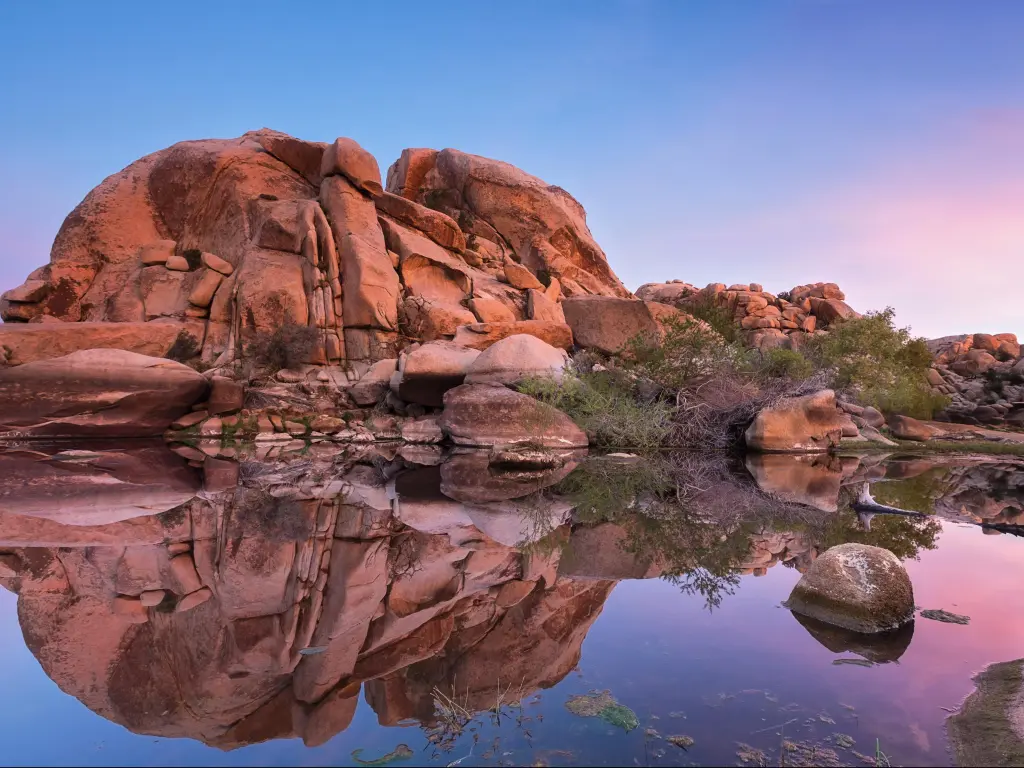
Why you should visit: Spread across a vast area of 794,000 acres, Joshua Tree is a combination of the Colorado Desert and the Mojave Desert - a perfect and unique marriage of two distinctive systems.
Tied together by the wonky, unique trees that the park is named after, Joshua Tree's two desert climates contrast in terms of elevation and topography. The Mojave Desert is known for being wetter and more fertile than the relatively empty and sparse Colorado Desert.
How to get there: One of California's prized possessions, the Joshua Tree National Park is an excellent place to drive to for a weekend getaway, mainly due to its proximity to San Diego. You can drive there in 3 hours.
Located in the deserted region of California, the easiest way to get there is via Interstate 15 North and California Route 60 East will drive you through Palm Springs, Coachella Valley, and other resort destinations before you make your way to the national park.
Our highlights: Echo Cove, home to nearly 8,000 rock formations, is perfect for rappelling or rock climbing. While you're in the area, be sure to take in the stellar outlook at Keys View, the end to a challenging but rewarding hike.
Cholla Cactus Garden is also a favorite among hikers, who are spoiled for choice at Joshua Tree with several trails to explore the various regions of the park.
All in all, Joshua Tree National Park is perfect for beginner rock climbers, nature adventurers, and even someone looking for a day break from the otherwise bustling city life. In our opinion, the best time to visit the Park is between March-May and October-November.
READ MORE - Road Trip from San Diego to Joshua Tree National Park
2. Channel Islands National Park, California
3 hours from San Diego (190 miles)
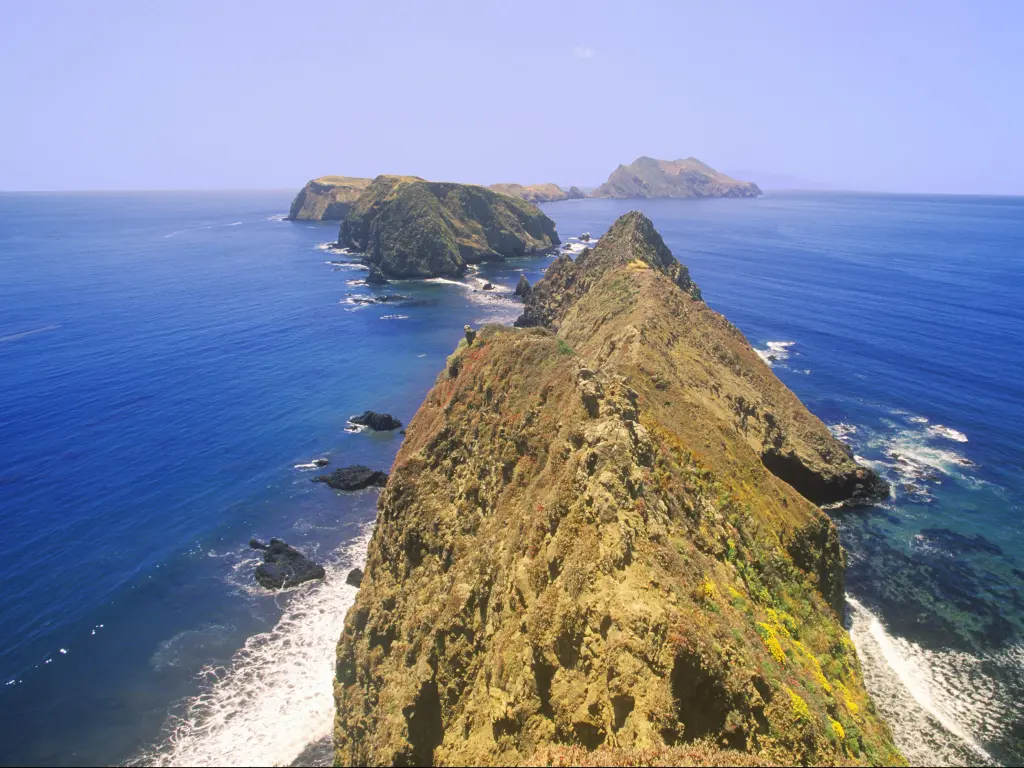
Why you should visit: Irrespective of distance, the Channel Islands National Park is a must-see due to its unique sea caves and beautiful views of the Pacific - which many choose to enjoy by kayak.
Luckily for those in San Diego, this stunning national park is less than 200 miles away and is one of the closest to the city.
How to get there: Since the park comprises five different islands scattered off the California coast, the driving element of this trip ends at Ventura, where you can take a ferry to the islands.
The most direct route to get to Ventura is via Interstate 5 North until Los Angeles, where you can exit onto US Route 101 North which will lead you straight to Ventura.
Though this route is more straightforward, you're bound to encounter heavy traffic in the Los Angeles area: something you'll definitely want to avoid if possible. Thankfully, there is an alternative. Exit onto Interstate 405 North right outside of Irvine and continue onto US Route 101 North.
Our highlights: Once you arrive at the Channel Islands, you'll find that each island has different things to do and other sights to admire:
- Santa Barbara Island: the smallest island, known for its rich history of past inhabitants and a large population of California Harbor Seals, Elephant Seals, and other species.
- Anacapa Island: a quaint island, great for hiking, exploring, and admiring the sunset from Inspiration Point.
- Santa Cruz Island: features several caves, including one that has murals painted all over it.
- Santa Rosa Island: boasts a large population of Torrey Pines, making it a lush island forest.
- San Miguel Island: the biggest of the Channel Islands (at 9,500-acres) with several ancient ruins, wildlife, and campgrounds for a unique island camping expedition.
A one-of-a-kind national park, it is perfect for a weekend getaway from the city, especially if you visit in the summertime when you may get to see a Blue Whale or a Humpback Whale!
READ MORE - Road Trip from San Diego to Channel Islands National Park
3. Death Valley National Park, California
5 hours 15 minutes from San Diego (280 miles)
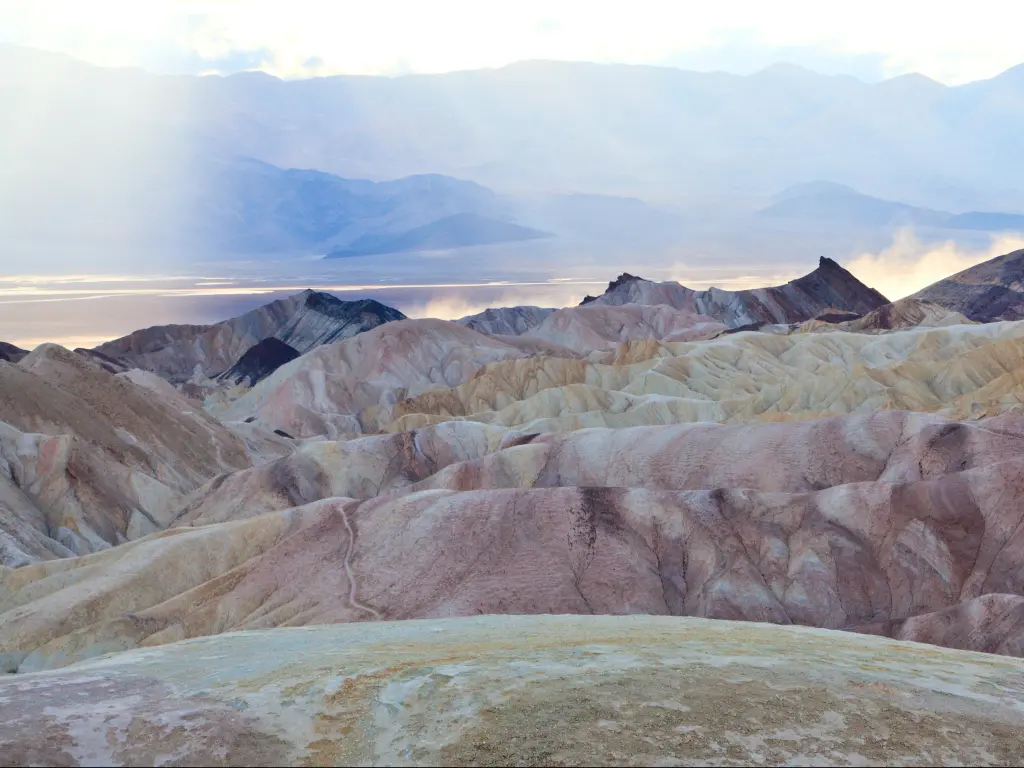
Why you should visit: Death Valley is a world-renowned phenomenon in itself. Ranked as the hottest place on the planet in numerous years, the impressive Death Valley National Park is a must-visit due to its truly unique atmosphere.
The mercury has hit 130 degrees Fahrenheit at Death Valley in 2020 and 2021, and the Park has famously been named as the "land of extremes" due to its weather conditions and topographical contrasts.
How to get there: Death Valley National Park is located just a five-hour drive from the city of San Diego, in eastern California. You'll spend most of the 280-mile journey on Interstate 15 North and Interstate 215 North, passing through classic California destinations like Riverside and San Bernardino.
You'll continue onto US Route 395 North and drive through the mountains of eastern California to make it to your destination.
Our highlights: Death Valley National Park is home to Badwater Basin - a collection of salt flats located 282 feet below sea level - as well as Telescope Peak, an 11,048 feet tall mountain with unreal views of the valley and beyond.
It's impossible not to be impressed by Death Valley National Park. In the spring, the valley blooms with yellow and orange-hued wildflowers, perfect for a walk through the golden flowers, at golden hour, in the golden state.
You'll also find Artist's Drive, a 9-mile long scenic road that runs through the Black Mountain Range, and the Devil's Golf Course, a one-of-a-kind golf course located on salt flats. While this might not be the place to get your regular 9-hole game in, it's still a great attraction to visit.
You can also explore Racetrack Playa, a dry lake with supposed “sailing stones” that move due to floods and winter freeze in the region. If you happen to visit the Devil's Hole, you'll also find unique fish species that have adapted to the desert landscape of Death Valley.
For obvious reasons, we don't recommended to visiting Death Valley in the summer due to its soaring temperatures. Regardless of what time of year you visit, though, make sure you stay hydrated, especially in the higher regions of the Park.
If you visit Death Valley in February, you can admire the amazing sights of the Milky Way during the Death Valley Dark Sky Festival. For more information on other activities to do and places to visit on your way to Death Valley, check out our comprehensive road trip guide.
READ MORE - Road Trip from San Diego to Death Valley National Park
4. Sequoia National Park, California
6 hours from San Diego (330 miles)
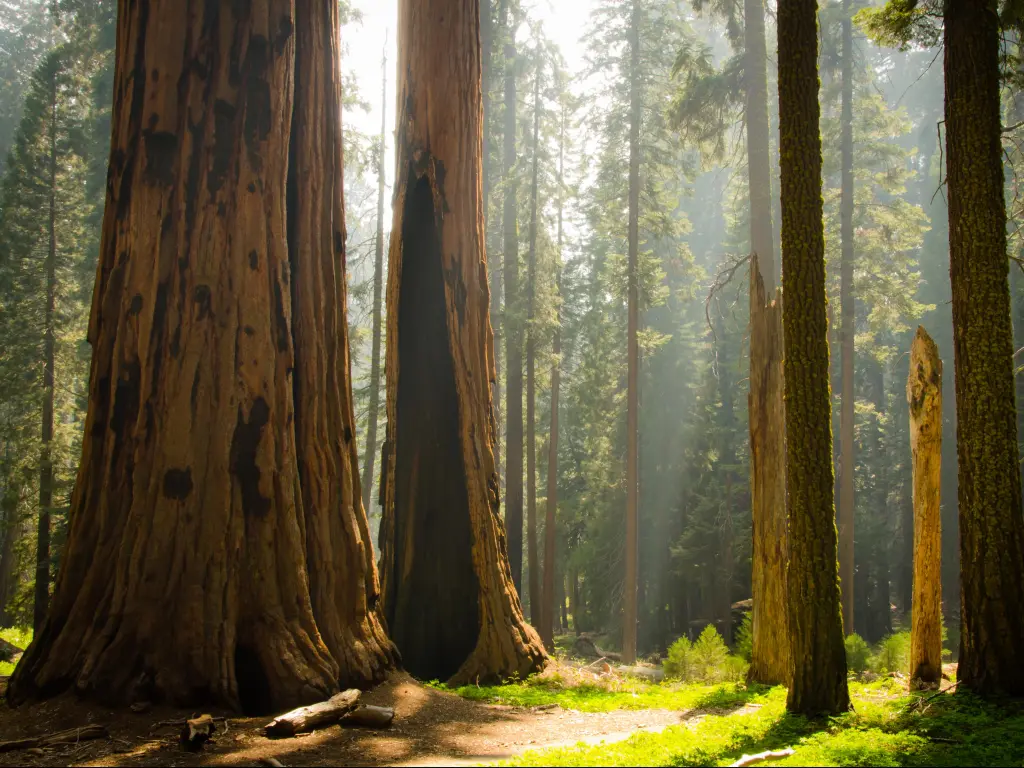
Why you should visit: With its giant sequoia trees, barren outback campgrounds, and the Giant Forest Museum, Sequoia National Park is the perfect weekend antidote to the city, and is a feasible 6 hours' drive away.
Sequoia National Park is located in Sierra Nevada, California, within the Sequoia National Forest. The park is adjacent to Kings Canyon National Park, and it is therefore entirely possible to combine the two in one epic trip. The area in general is home to over 400,000 acres of protected mountainous terrain.
How to get there: The best way to get to the park is via Interstate 5 North until exiting onto California Route 65 outside Bakersfield, heading towards Sequoia National Park.
From Bakersfield, the route is an easy 1 hour 45 minute drive. You'll find a particularly scenic stretch just past Lemon Cove, where the road runs alongside Lake Kaweah.
If you're intending on stopping for a picnic en route to Sequoia, try one of the recreation areas next to Lake Kaweah: Horse Creek Recreation Area and Slick Rock Recreation Area are both great, scenic spots for a bite to eat - and photo opportunities!
Our highlights: One of the main attractions of the park is the 270 feet tall General Sherman Tree. At the time of writing, it is the bulkiest tree in the world, weighing a total of four and a half million pounds.
The best way to get to this tree is via the Sherman Tree Trail which ventures through a large group of sequoia trees, leading to the base of General Sherman.
Other attractions in the park include a marble cavern called the Crystal Cave, which can be explored with a 50-minute guided tour. Another highlight is popular look-out point Moro Rock: a granite dome rock formation in the center of the park with stunning views of the Great Western Divide.
The annual Dark Sky Festival gives visitors an opportunity to experience tours, musical performances, movies, and lots more, all while celebrating and exploring the night sky, full of stars.
This Festival takes place across various locations in Sequoia - as well as Kings Canyon National Park (Sequoia's sister park) - giving visitors the chance to explore the diversity of both parks while marveling at the wonders of the galaxy.
The ideal time to visit Sequoia National Park is in the summer months in order to see unique wildlife and enjoy the rising streams and waterfalls. However, no matter when you visit, your trip is bound to be one you'll not forget!
5. Kings Canyon National Park, California
6 hours 30 minutes from San Diego (360 miles)
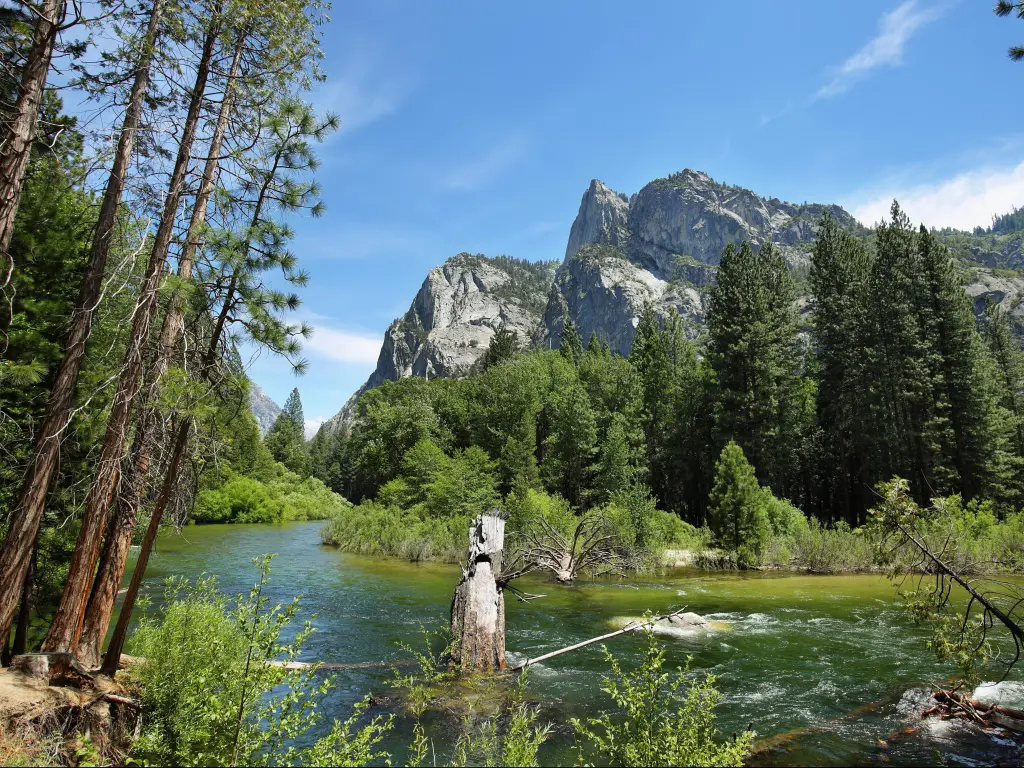
Why you should visit: One of the lesser-known parks on our list, Kings Canyon National Park is perfect for a peaceful getaway from the city. You'll get less of the crowds - but no shortage of natural beauty.
Located less than 7 hours from San Diego in the Sierra Nevada Mountains right by the Sequoia National Park is the Kings Canyon National Park. It is one of the most serene places in the whole of California. Take a trip here for varied hikes, scenic viewpoints and thick lush forests.
How to get there: The best way to reach Kings Canyon is via Interstate 5 North until Bakersfield and then driving the rest of the way on the Golden Highway until you reach Kings Canyon Road.
Since they're connected and managed by the same group, visiting the Kings Canyon National Park and Sequoia National Park during one trip is ideal.
Our highlights: The park has several different regions to explore, like the John Muir Wilderness, the River Falls, Kings River and beautiful Monarch Lakes. The park is also home to a massive General Grant Tree (which stands tall at 267 feet) located in the Grant Grove.
Some of the adventure excursions you'll be able to engage in within the park are backpacking, horseback riding, rock climbing, fishing, and even winter sports like snowboarding if you happen to make the trip in December or January.
Native species that call Kings Canyon home include Spotted Skunks, Bobcats, Gray Fox, Black Bear, Mountain Lions, as well as many reptiles, amphibians, and a huge variety of birdlife.
Come to Kings Canyon for the serenity - stay for the sheer variety!
6. Pinnacles National Park, California
6 hours 30 minutes from San Diego (390 miles)
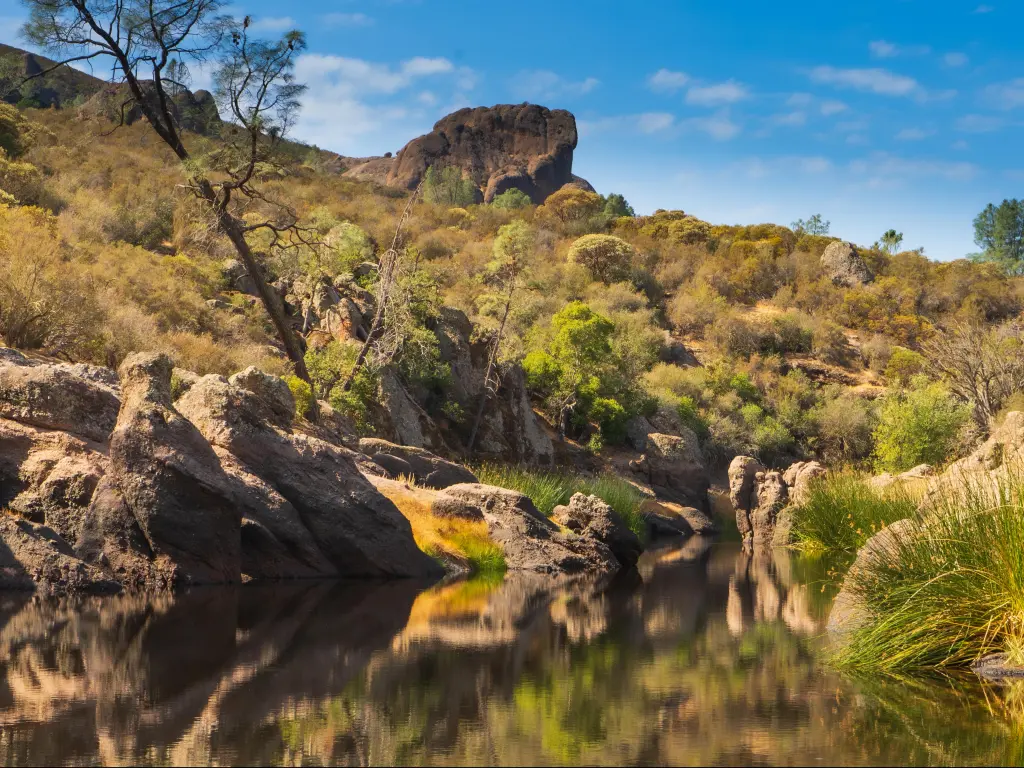
Why you should visit: The smallest and newest national park in California is the Pinnacles National Park, less than 400 miles from San Diego.
Pinnacles National Park can easily be bundled in with other California classics nearby, such as Pfeiffer Big Sur State Park and Monterey Bay on the stunning Pacific Coast. This is the perfect area for a weekend trip from San Diego.
How to get there: The best route from San Diego is via Interstate 5 North until over halfway there and then state routes until you get to Pinnacles National Park.
The region was designated as a national park in 2013 and is conserving the mountainous region of the eastern Salinas Valley. Pinnacles National Park is heavily populated with rock formations that came about as a result of a volcanic explosion on the San Andreas Fault line.
Our highlights: Within the park, you'll find several hikes to explore the best of the region and capture panoramic views of the area. Our favorite of these is the Bear Gulch Loop.
Besides the rock structures, the region is famous for inhabiting the California Condor, a heavily endangered bird, making it a hotspot for bird enthusiasts hoping to capture a photo of the beautiful bird.
The park is open all year round, though the summers can become too hot to explore the region comfortably. The best times to visit are the early spring or the latter half of autumn, so you can explore without feeling too uncomfortable in the heat.
Relatively new compared to other national parks, the Pinnacles National Park is progressively growing in popularity and is a great place to explore over a lazy summer weekend.
7. Saguaro National Park, Arizona
5 hours 45 minutes from San Diego (400 miles)
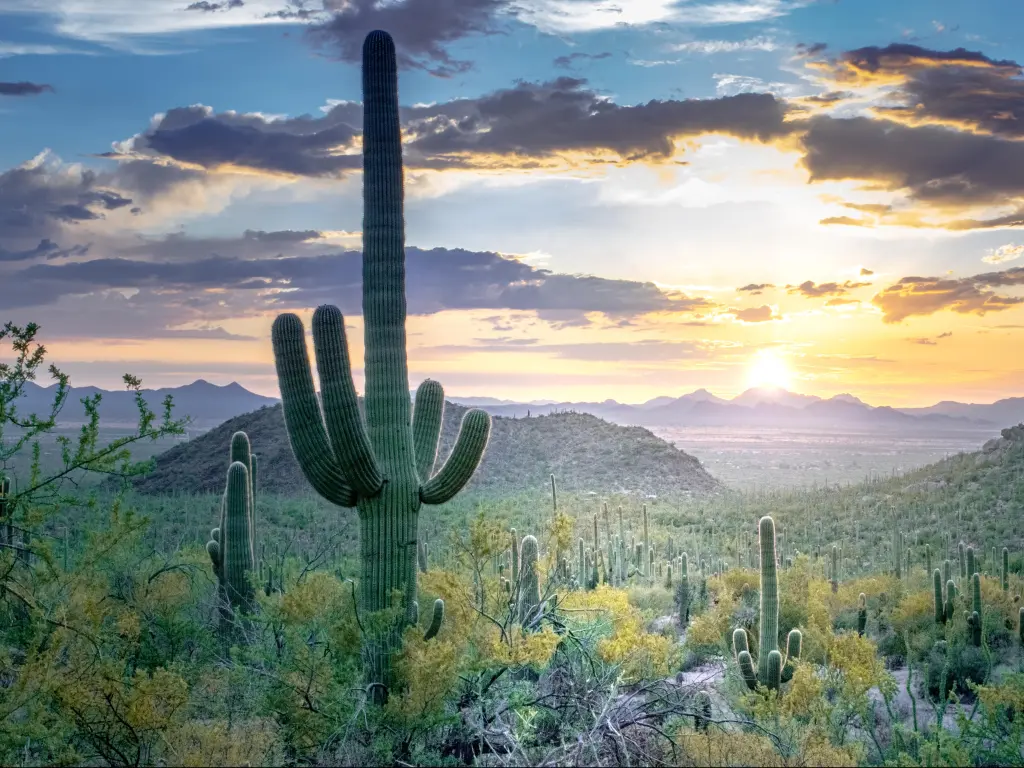
Why you should visit: Named after the gigantic Saguaro cacti that are synonymous with the American Southwest, Saguaro National Park is worth exploring just to marvel at these staggeringly huge succulents,
But there's so much more here besides: Saguaro National Park is also home to inspiring petroglyphs created by the ancient Hohokam people, as well as numerous trails and impressive views of its rugged desert setting.
How to get there: Situated 400 miles from the city is the Saguaro National Park in southern Arizona. The park lies on the outskirt of Tucson, perfect for a weekend trip to the city with some urban exploration and adventure.
From San Diego, take Interstate 8 East until you reach the outskirts of Tucson. At this point, switch to Interstate 10 East for the last leg of the journey.
Our highlights: Divided into two different sections - each with diverse landscapes and activities to offer - the park as a whole is excellent for a day excursion.
The eastern part of the park, known as the Rincon Mountain District, has more trails with scenic views and is famous for a scenic road called the Cactus Forest Drive.
The park's western segment, known as the Tucson Mountain District, has a denser Saguaro cacti forest along with petroglyphs of past Native American residents.
The Saguaro Cactus, which is an essential part of the park, is a large tree resembling cactus species that also blooms in the spring and summertime, so if you want to spot a beautiful white flower growing on a massive prickly cactus, that's the best time to visit.
The desert-like region also supports several other life forms like Gray Fox, Ground Squirrels, Gila Monster, Diamond-Backed Rattlesnake, Vermillion Flycatchers, and more.
The cacti can live up to 250 years and are truly a marvel to look at, so if you're interested in unique landscapes, low elevation trails, and beautiful sunsets in the autumn time, the Saguaro National Park is an excellent park for you.
8. Yosemite National Park, California
7 hours 10 minutes from San Diego (440 miles)
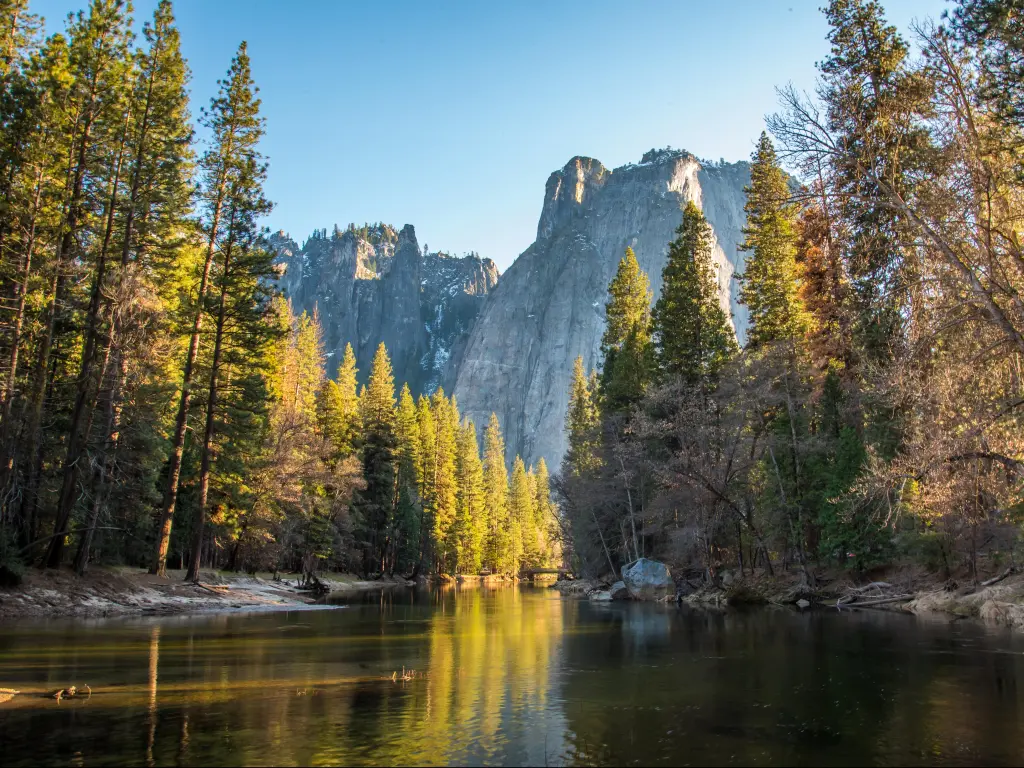
Why you should visit: Spanning 748,436 acres in the Sierra Nevada Mountains in California, Yosemite is possibly one of the most famous national parks not only in the US but the world.
Yosemite National Park is a habitat of cascading waterfalls, immensely tall Sequoia trees, awe-inspiring rock structures, and so much more. Located just over 400 miles from San Diego by road, a road trip to this oasis is bound to be a treat.
How to get there: Though you could champion the drive in a day, you could also start on a Friday evening after you finish work and cover some part of your trip before stopping for the night and continuing your journey the next day.
The easiest way to get to your destination is through Interstate 5 North which will drive you through Irvine, Los Angeles, Bakersfield, and Fresno, which you can explore along the way.
Our highlights: At the park, you'll get to admire breathtaking waterfalls like Yosemite Falls (2,425 feet tall) and Bridalveil Falls (620 feet). Other highlights include Tunnel View, El Capitan, and Half Dome - all rock structures that draw thousands of climbers each year.
Home to a vast variety of flora and fauna, especially that which is indigenous to California, the valley has countless things to discover, observe, and admire. One of the most well-known species in the park is the majestic Black Bear, and Yosemite is believed to house nearly 500 of them.
Yosemite is also one of the few places where you're able to experience lunar moonbows - where a full moon, clear sky, and waterfall mist come together to create a rainbow. Truly amazing.
With up to 750 miles of trails, iconic overlooks, and a museum packed with the history of the landscape and its inhabitants, and beautiful valleys (especially in the fall season), the Yosemite National Park is truly one of a kind.
Make sure to read our comprehensive road trip guide from San Diego to Yosemite National Park to find out more!
READ MORE - Road Trip from San Diego to Yosemite National Park
9. Zion National Park, Utah
8 hours 10 minutes from San Diego (490 miles)
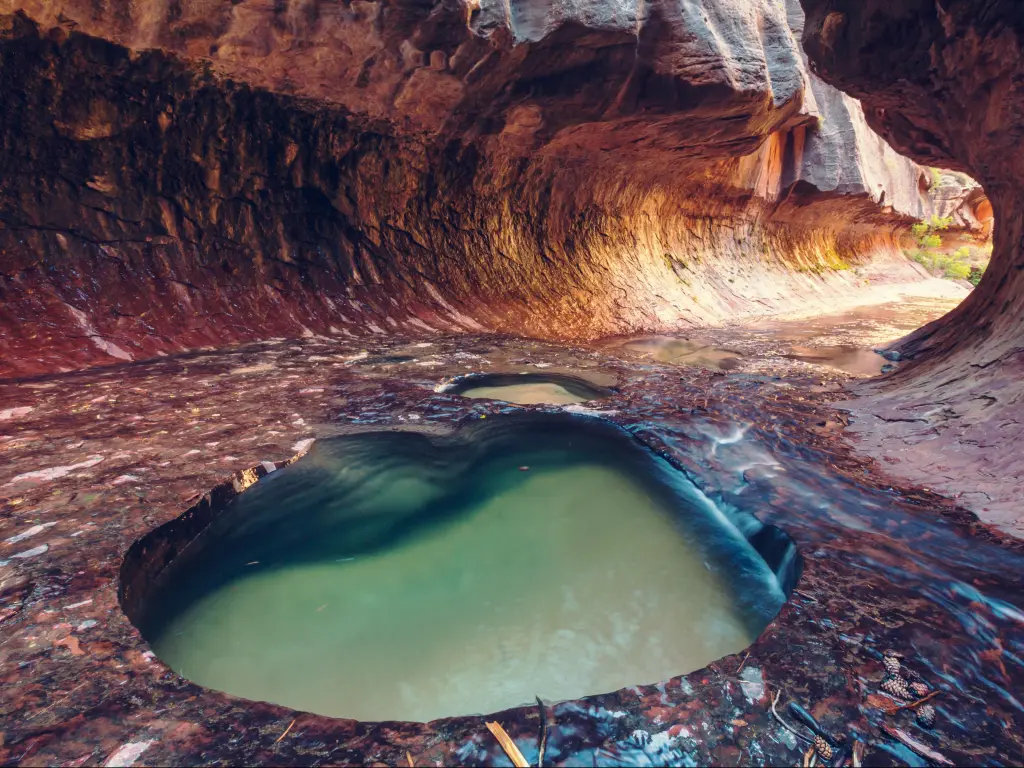
Why you should visit: For reasons that will become obvious, Zion National Park is one of the most visited national parks in the country and is spread across 148,016 acres in southwestern Utah.
And though it's 500 miles from the San Diego, the drive through the California mountains and Utah canyons makes this a road trip that's vacation-worthy in its own right.
The Park is known for being a hiker's dream because of its 2,000 feet tall sandstone cliffs. The Narrows is a region of the park that is home to some of the park's best hikes and panoramic views.
How to get there: Though the drive is possible in a day, you could break the road trip into two days and stop over in Las Vegas for the night, especially as "Sin City" is located around the halfway mark on your route.
The journey to Utah - through California, Nevada and Arizona - will mostly be spent on Interstate 15 North, which is a truly scenic drive for the most part.
Our highlights: Though the trails at Zion National Park vary in difficulty and altitude, the Angels Landing Trail, a 5-mile loop hike with over 1,500 feet of elevation gain, is a highly coveted trail to traverse for most intermediate to expert hikers.
If you'd like to hike up to Angels Landing, you will need a permit and will need to make a reservation. Check the Zion National Park's website for more details.
Besides the rugged and steep canyons, you'll also find Emerald Pools, cascading waterfalls and even hanging gardens. Horse Ranch Mountain, the highest point in the park, set at 5,000 feet, is a particular highlight among visitors.
The park is also inhabited by several endangered species, including the coveted California Condor and Mexican Spotted Owl. The park's distinctive topography is constantly changing, making it a unique place for admiring plant species that have evolved to survive in such harsh climates.
With petroglyphs of past inhabitants, the bubbling Virgin River that cuts through the canyons, and breathtaking landscapes, a visit to Zion National Park is a virtual no-brainer. Fall is the best time to visit the national park if you are a hiking enthusiast!
READ MORE - Road Trip from San Diego to Zion National Park
10. Petrified Forest National Park, Arizona
8 hours 45 minutes from San Diego (545 miles)
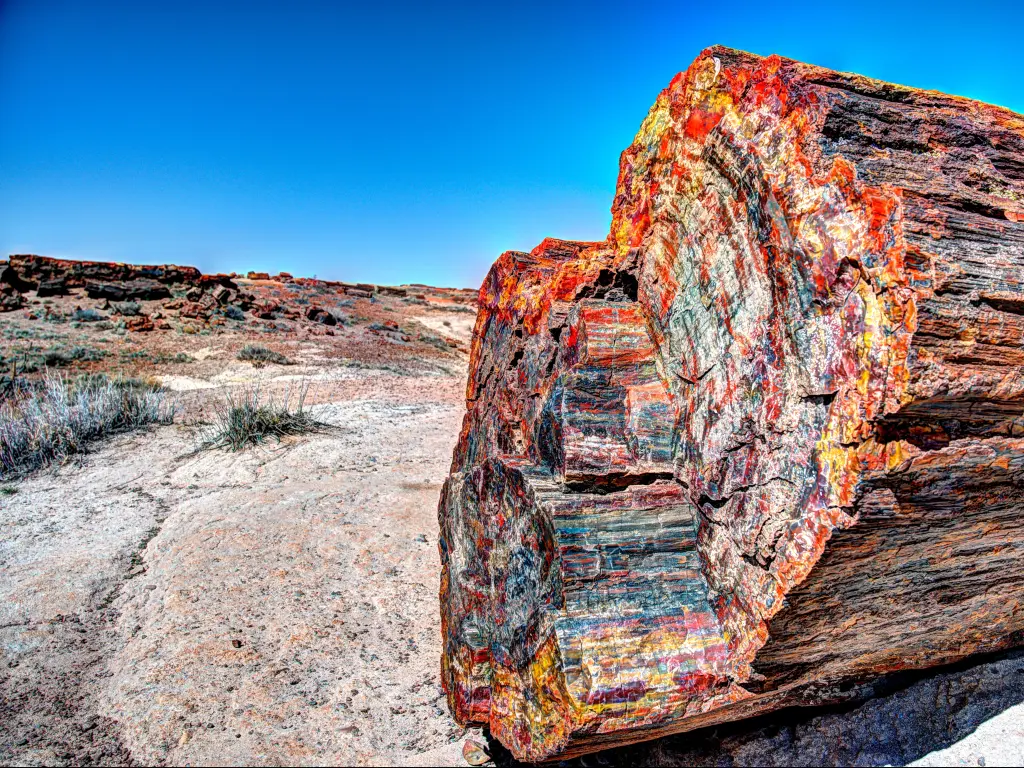
Why you should visit: The Petrified Forest National Park is a beautiful sweeping landscape in northern Arizona and is home to one of the world's most extensive collections of colorful petrified wood.
This landscape is believed to have been inhabited for the first time nearly 13,000 years ago by the Puebloan people, whose lives have been immortalized through the carefully preserved ruins.
How to get there: To get there, you'll begin your drive in San Diego via Interstate 8 East and drive close to the US-Mexico border before reaching Phoenix. The Phoenix-Scottsdale area is an ideal place to stay for a night if you choose to break the trip into a couple of days.
You'll then follow along Interstate 10 East for the rest of your journey through the Tonto National Forest before making your way to the national park.
Our highlights: Among the many attractions in the park, the Rainbow Forest is an excellent destination for a picturesque walk through the woods, even making it a great backdrop for photoshoots.
In stark contrast with this stunning woodland is the stark yet vibrant "Painted Desert" - a huge expanse of brilliantly colored terrain, spanning an area between the east end of the Grand Canyon National Park and the Petrified Forest National Park.
The park's landscapes have existed for over a million years and have evolved due to the region's several climate changes and topographical evolution.
To explore the best of the park, you can drive on the region's scenic road for stellar views of the park, go horseback riding, hike on the park's beginner-friendly trails, and even camp under the starry night.
A historically rich and mostly peaceful landscape, a visit to the Petrified Forest National Park is recommended for all those looking for a long weekend getaway from the city at any time of the year.
11. Grand Canyon National Park, Arizona
8 hours 20 minutes from San Diego (550 miles)
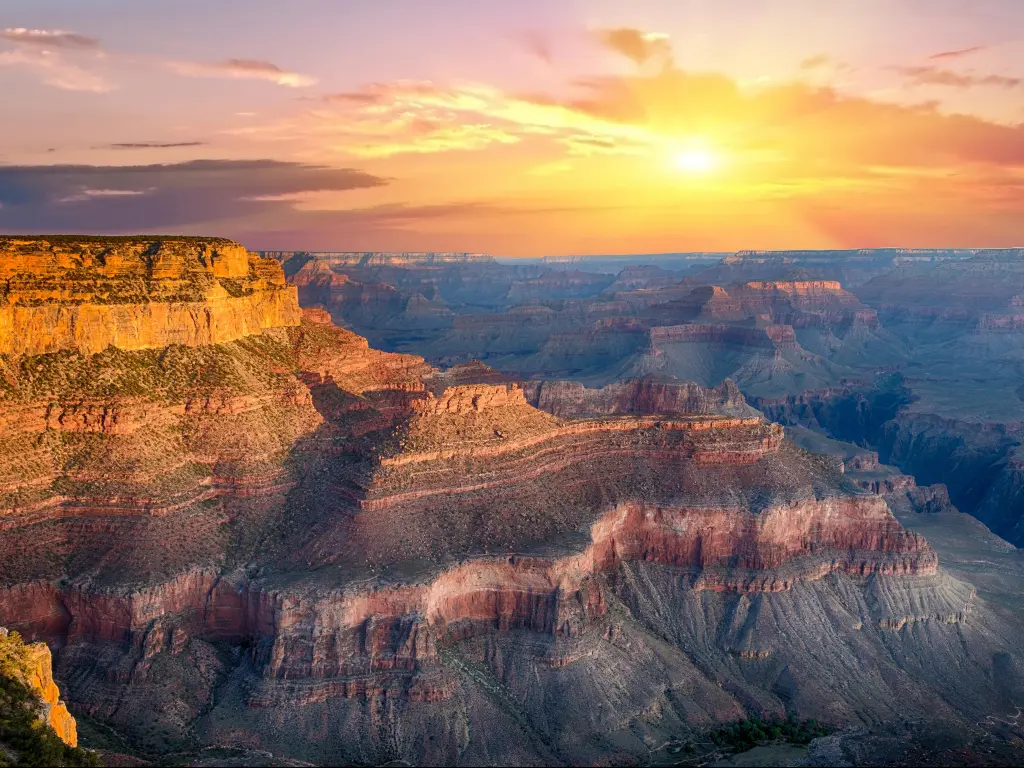
Why you should visit: A park that's top of most explorers' bucket lists, The Grand Canyon is a 550-mile drive from San Diego - and if there's only one park you can visit, it's got to be this one.
The Grand Canyon National Park has existed as a national park for over a hundred years - and it's been one of the most distinctive ecosystems in the world for centuries prior.
Back in the 1800s, the area was declared relatively valueless in terms of mining or tourism capabilities, but after President Theodore Roosevelt visited the park and stayed at the iconic El Tovar Lodge, people from all across the world began to flock over to the park and have only multiplied in number since.
The Grand Canyon is such an unmissable destination, well worthy of several vacation days. Why not combine your visit to the Grand Canyon with our suggested road trip route from San Diego to Dallas for an epic adventure!
How to get there: The best way to reach the Grand Canyon from San Diego is via Interstate 15 North which will take you to Arizona, where you'll merge with Interstate 40 East.
From here, you'll travel around 315 miles until you reach the small city of Williams, which is known by many as a gateway to the Grand Canyon National Park, with access by road and also using the heritage Grand Canyon Railway.
While in Williams, you might want to take in some road-trip nostalgia, with a visit to the famous Pete's Route 66 Gas Station Museum, with its selection of classic vehicles from years gone by.
Whether you choose to stop off in Williams or continue straight through, your onward journey to Grand Canyon Village is only one hour long. Once you reach Grand Canyon Village, you can park up and enter the National Park on foot.
As a road trip alternative, you could also follow our guide for a scenic drive around The Grand Canyon.
Our highlights: Divided into the North Rim and South Rim (due to its sheer size, it encompasses a massive area of 1.21 million acres), you'll find countless activities to immerse yourself in. Note that the North Rim is closed during the colder months.
You can go kayaking on the Colorado River that cuts through the canyons, admire the views from the Skywalk (an overlook with a glass floor, managed by the Hualapai tribe), or go on of the many hikes in the park.
There are so many unique natural features within the park that you'll have more to see even after a few visits. Explorers are still discovering new features of the park as time passes, which gives you an idea of its massive extent and geological richness.
The park has been a well-surveyed region for decades and owes a lot of its conservation to its past inhabitants, whose lives have been documented at the park's visitor centers.
You'll find species like the Bighorn sheep, California condors, Gila monster, Grand Canyon rattlesnakes (neon pink colored reptiles endemic to the area), and mules to name but a few.
The park is open year-round; though many parts of the North Rim are inaccessible in the winter months owing to harsh weather.
As such, we'd suggest visiting in early summer or the fall, especially if you're looking to camp in the park's campgrounds and would love to stargaze at the starlit sky.
READ MORE - Road Trip from San Diego to the Grand Canyon
12. Bryce Canyon National Park, Utah
9 hours 30 minutes from San Diego (590 miles)
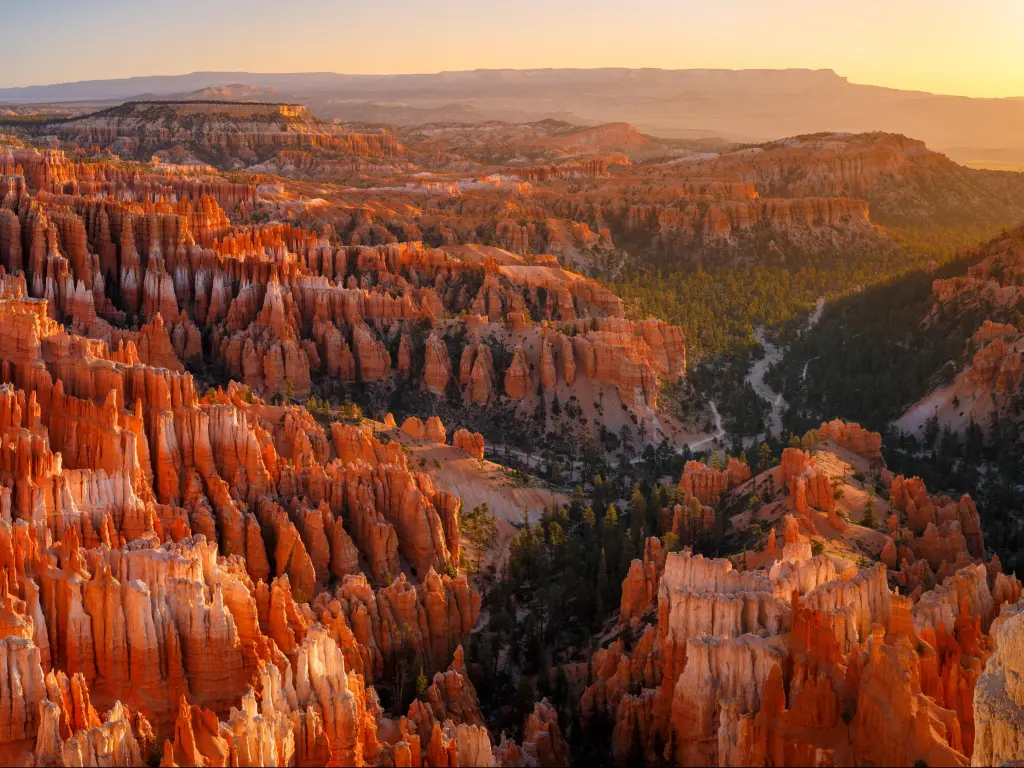
Why you should visit: Situated nearly a 10-hour drive from the city is Bryce Canyon, a national park famous for its unique rock formations called the red-rock hoodoos.
The Bryce Canyon National Park has enjoyed federal park status for nearly a century and is a fantastic place for a visit when traveling to the Utah national parks.
Ideally, you can combine your trip to Bryce Canyon National Park with Arches National Park, Glen Canyon Recreational Area, and other scenic spots for a power-packed nature trip in Utah.
How to get there: You can break the drive into two days, and the best way to get there is via Interstate 15 North, a scenic route that will take you through the California desert, Las Vegas, and Utah's arid regions before arriving at your destination.
Our highlights: The park's hoodoos and other rock formations are natural amphitheaters made up of sandstone, limestone, iron, and other elements over millions of years.
The natural sand erosion due to the changing climate and harsh weather conditions gave rise to these unique rock structures that the national park has preserved.
There are several places within the park to explore and enjoy, like Sunset Point, Bryce Point, and Rainbow Point - which is set at over 9,000 feet in elevation. Each offers sweeping views of the scenery and beyond.
The park also has numerous hikes and trails for visitors to indulge in the park's beauty. If you're a beginner when it comes to hiking, however, you may find some of these trails quite challenging. Be sure to check advice before you set out.
Situated at a high altitude, it's essential to stay hydrated and be prepared in case of any unpredictable weather changes. If you visit in the winter, you'll be able to catch a glimpse of the other jagged red rocks covered in pristine white snow.
Bryce Canyon is also an International Dark Sky Park, and is famous for having one of the darkest skies in the country - especially on a moonless night. You'll find that the stargazing experience is fantastic here.
13. Great Basin National Park, Nevada
10 hours from San Diego (630 miles)
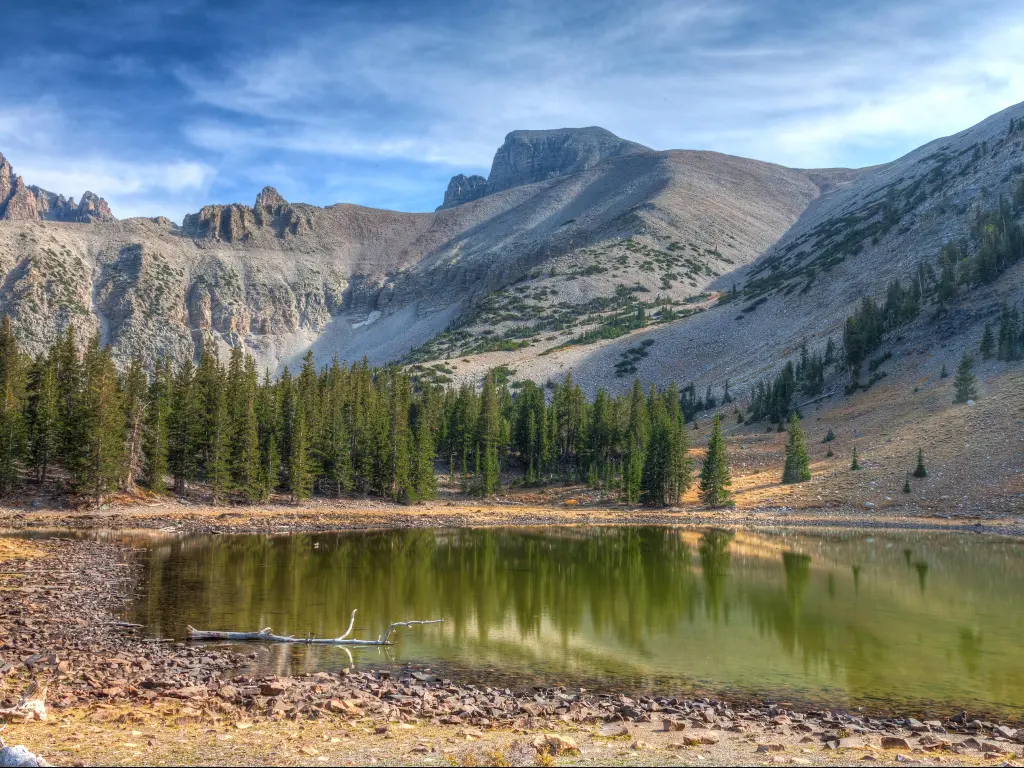
Why you should visit: Spread across 77,100 acres, The Great Basin National Park appears barren and desolate at first glance. In reality, this park an oasis of unique plant and animal life that has survived in a distinctive climate.
How to get there: The Great Basin National Park is located a 10-hour drive from San Diego and is the perfect place to head to if you want to enjoy some peaceful time in nature, devoid of loud crowds, long queues, and jam-packed parking spots.
To get there, you'll drive on Interstate 15 North until you reach Las Vegas, where you can book a hotel for the night, enjoy dinner and drinks on the strip, and maybe even hit up a casino before continuing your journey the next day.
You'll then exit onto US Route 93 North which will drive you to the edge of Nevada (near the Utah border), where this barren landscape is situated.
Our highlights: Great Basin National Park is home to Wheeler's Peak, which stands tall at 13,060 feet above sea level. The Lehman Glacier and the Lehman caves (known for their peculiar but admirable structures) are also well worth a visit while touring Great Basin.
The park also has different trails, most famous of which are the Mountain View Nature Trail, The Baker Creek Trail (leading you to the park's lakes where you can go fishing), Stellar Peak Trail, and Wheeler Peak trail, all of which are a great way to explore the park's best views.
Due to being located in a remote region coupled with low humidity levels, the Great Basin National Park is one of the top-tier places to visit if you're into stargazing, especially if you choose to camp in one of the park's high-altitude campgrounds.
In fact, you can also indulge in the annual Great Basin Astronomy Festival that takes place in September and involves numerous astronomy and stargazing-related activities.
14. Capitol Reef National Park, Utah
10 hours 30 minutes from San Diego (650 miles)
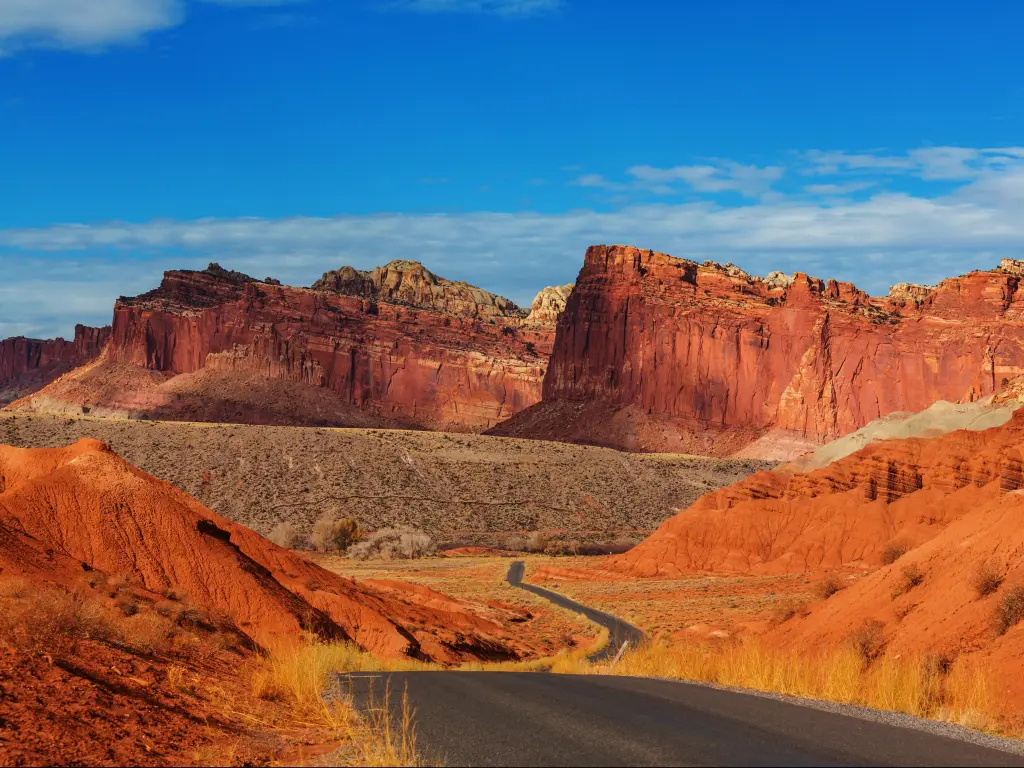
Why you should visit: Capitol Reef National Park in Utah was named after its two very different terrains: “capitol” referring to the beautiful sandstone dunes that resemble the white house's white dome; and “reef” for the park's jagged rock range that looks like the coral reefs usually found in the ocean.
Spread across 241,904 acres, the region has been lived in by Navajos, Mormon Settlers, Paleo Indians, and several other groups before becoming a national conservation area.
How to get there: Located a 10-and-a-half-hour drive from the city, this colorful landscape is totally worth the drive over a long weekend. To get there, you'll follow Interstate 15 North through the California desert into Nevada and Arizona, and Utah's Dixie National Forest to make it to the national park.
Our highlights: In the park, you'll come across the Waterpocket Fold, a unique geological wrinkle on the earth's surface known as a monocline.
To give you an idea of the sheer variety in this park, you'll also find ancient petroglyphs, as well as extensive orchards with pears, apples, berries and peaches that you can pick if you visit in season.
To best enjoy the views, you can go camping, hiking on the park's many trails, canyoneering, rock climbing, horseback riding, and more. You'll find beautiful rock structures and wonky sandstone formations set in a somewhat isolated region, ideal for a serene holiday away from the crowds.
Offering panoramic views, historically-rich landscapes, and fresh fruit, this lesser-visited park would be lovely to tour on a weekend away from San Diego, especially during fall and spring.
15. Lassen Volcanic National Park, California
10 hours 40 minutes from San Diego (660 miles)
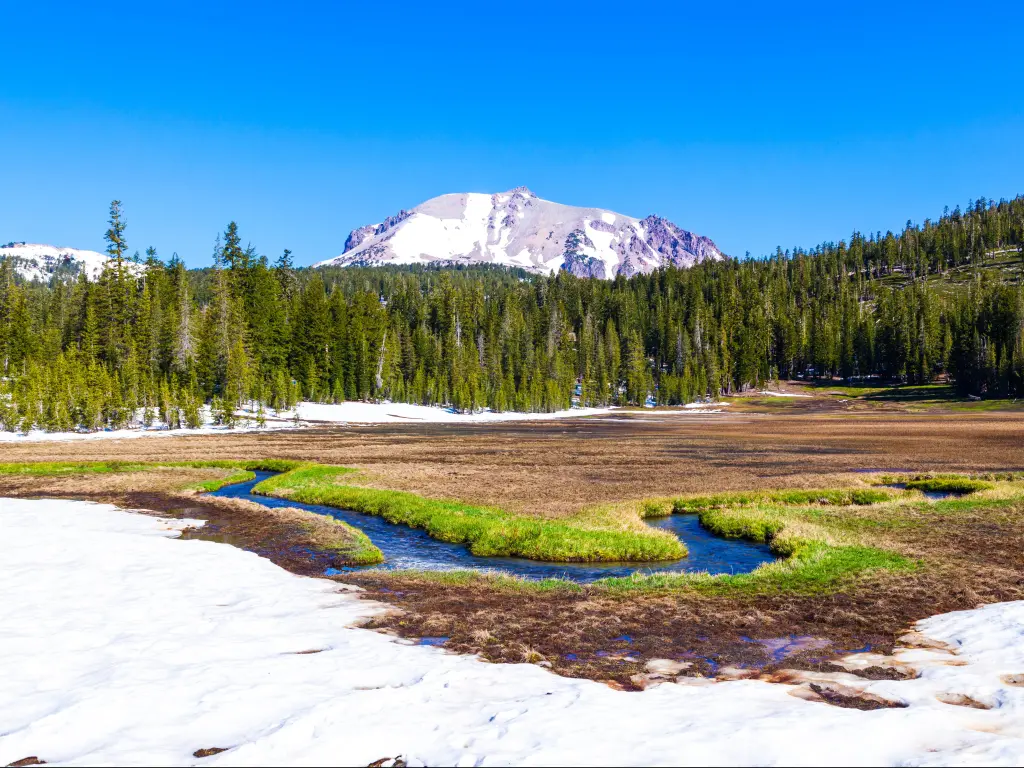
Why you should visit: A combination of wildflower valleys, unique hot springs, and breathtaking high-altitude lakes, the Lassen Volcanic National Park located in northern California is one of the best destinations near San Diego.
Lassen Peak was formed after the eruption of one of the infamous "Ring of Fire" volcanoes: a series of active volcanoes and areas of heightened seismic activity. As a result, Lassen Peak is one of the most distinctive landforms you're likely to see in a national park.
The peak last erupted in 1914 until 1917 and has remained dormant since. Besides Lassen Peak, you'll find all the four different types of volcanoes that exist within the park boundary.
The picturesque lakes that you'll explore within the region were, in fact, formed because of the molten lava solidifying and causing ridges on the ground.
How to get there: A 650-mile drive, the fastest way to get to Lassen Volcanic Park is by following Interstate 5 North through famous California cities like Los Angeles, Santa Monica, Burbank, and Sacramento.
We suggest you take the opportunity stay the night in the Sacramento area and then continue onto state routes to cover the final miles of the trip.
Our highlights: Activities on offer at Lassen Volcanic National Park include swimming, boating and - of course - hiking. There are also several ranger-led programs, including a Starry Night hike on Cinder Cone trail on a full moon night. An out-of-this-world experience!
In the winter and spring months, the roads within the park are closed to cars due to the snowy conditions, so it's best to visit in the summer, specifically the months of July and August.
16. White Sands National Park, New Mexico
10 hours 50 minutes from San Diego (740 miles)
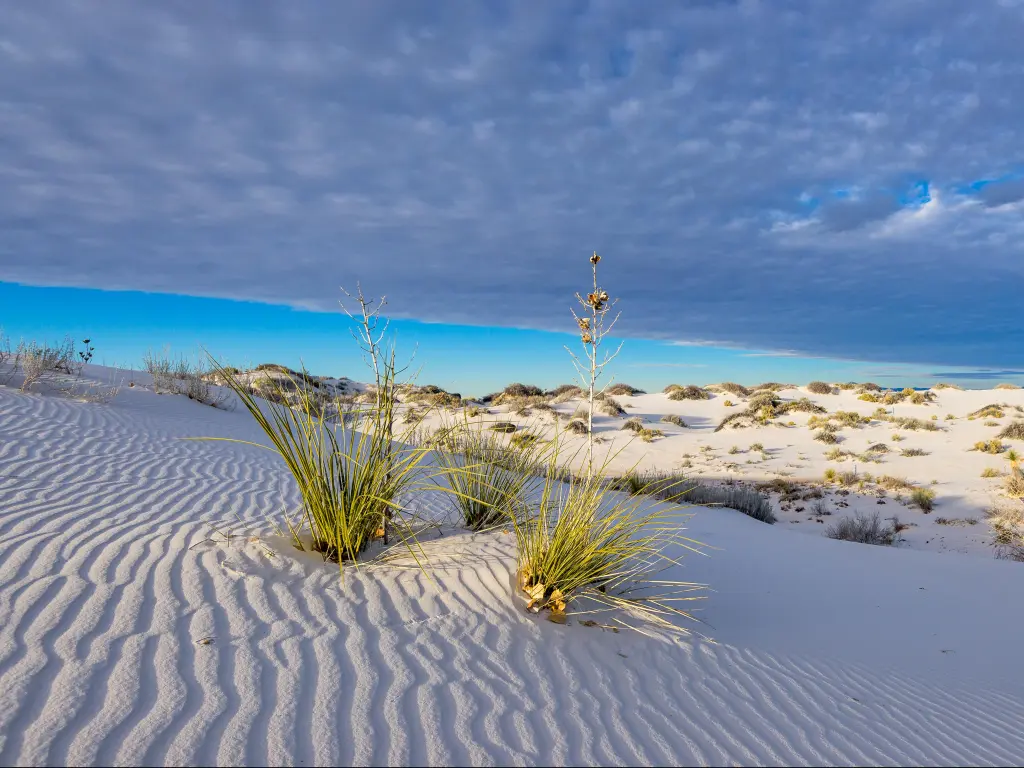
Why you should visit: As one of the country's newest national parks, the White Sands National Park has already become a favorite among adventurers. Located in New Mexico, nearly 11 hours by road from San Diego, this sprawling pristine white landscape is sure to be worth the trip.
The park's surface is made up mostly of gypsum, which is what gives the region a lot of its unique features. Gypsum as an element very seldom appears in solid form and, although gypsum is transparent, its crystals appear white due to friction.
The properties of gypsum also mean that the crystals don't absorb the heat and remain cold. This is quite a phenomenon to experience in the height of summer in New Mexico!
How to get there: To get to White Sands National Park, you'll follow Interstate 8 East into Arizona and exit onto Interstate 10 East just outside Tucson.
After entering New Mexico, you'll pass through las Cruces, a small city surrounded by mountains, before reaching the distinctive landscape that is the White Sands National Park.
Our highlights: At the park, you'll spot the African Oryx (otherwise only found in regions in East Africa), fossilized Ice Age footprints, as well as many nocturnal wildlife species that have evolved to adapt in such a distinctive landscape.
The park's dunes are also fascinating to explore - you can choose to hike them or even go sand-sledding or boarding (boards are available to rent at the park's visitor centers).
One of the most coveted hikes in the park is the trail leading to Lake Lucero, which is no longer a water body but a bed of salt flats with selenite crystals around it.
The White Sands National Park is a gypsum-covered dreamscape that is best visited in spring and summer. This may be a relatively new national park, but it still holds its own as a first-rate destination.
17. Mesa Verde National Park, Colorado
12 hours 30 minutes from San Diego (780 miles)
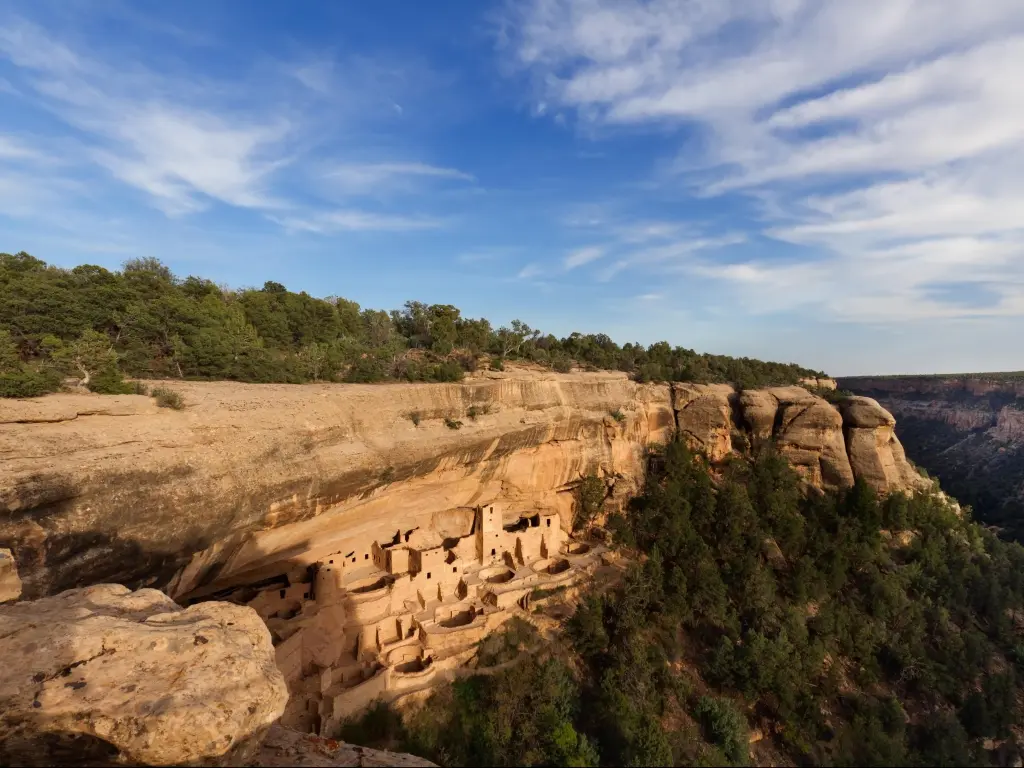
Why you should visit: Mesa Verde National Park, located in southwestern Colorado, is one of the most historically rich parks - perfect if you're a history buff heading for the great outdoors.
Mesa Verde's wealth of ancient monuments pay homage to the region's ancient heritage and its past Native American inhabitants. It's also home to countless cliff dwellings.
The most well-known of these is Cliff Palace, which is regarded as the largest cliff dwelling of its kind in all of North America, and the Chapin Mesa Archeological Museum has interactive exhibits paying homage to the 26 tribes that lived in and nurtured this region.
How to get there: Around 800 miles from San Diego by road, the fastest way to get to Mesa Verde is via Interstate 8 East until you reach Arizona, and after stopping over for the night in Phoenix, you can follow Interstate 17 North to reach New Mexico.
US Route 160 East will take you through the deserted plains of New Mexico into Colorado and ultimately to the park's entrance.
Our highlights: You can also go on a scenic drive on the Mesa Top Loop Road for stunning unobstructed views of the dwellings, observe the petroglyphs that you'll find across the park, and dine with a view at the Metate Room (with an emphasis on Native American artwork regional cuisine).
Though the park is open all year round, the winter can bring some snowstorms, so it might be tricky to make the trip in those months. It's recommended to visit in the summertime, though the temperatures can soar, so be prepared!
18. Arches National Park, Utah
11 hours 50 minutes from San Diego (790 miles)
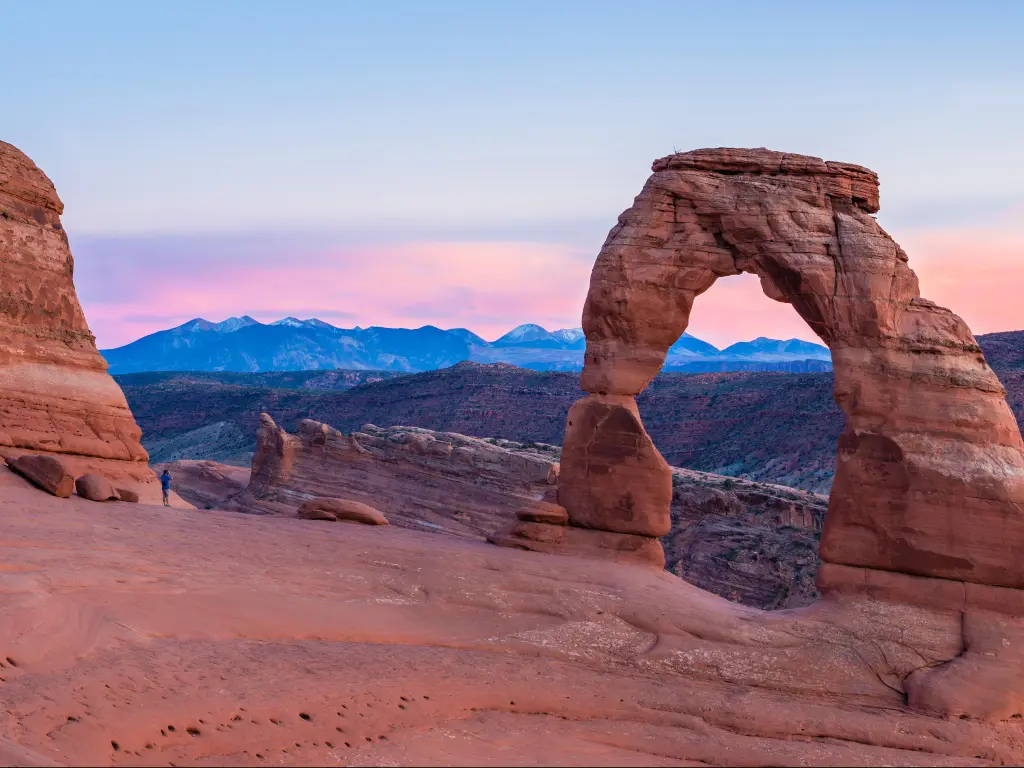
Why you should visit: Situated a little short of a 12 hours from San Diego is the iconic Arches National Park. The crown jewel of Moab, adjacent to Canyonlands National Park, this park is home to 2,000 naturally occurring sandstone arches.
These natural wonders can about as a result of weathering and sand erosion that took place centuries ago. Amongst the rock structures, you'll be able to spot Foxes, Bobcats, Mountain Lions, and several nocturnal animals.
How to get there: The best route to get to Arches National Park (and Canyonlands National Park since it's across the road) is through Interstate 15 North up you enter Utah and then following Interstate 70 East and local routes to Moab and Arches National Park.
Our highlights: One of the best ways to explore this 76,679-acre park (and all 2,000 arches) is on a ranger-led program. There are several offered here.
You can take a Private Petroglyph Tour, enjoy a 4x4 adventure or take a well-loved Fiery Furnace hike. There are also several self-guided trails that you can go on, including the Devils Garden Trail.
Set at an elevation of 4,000 feet, the temperature can fluctuate rapidly, especially if you're visiting in the winter season.
As an International Dark Sky Park, the view of the sandstone arches with the moon shining bright on a full moon night is magical. Even photographers agree: the popularity of night photography in the area has only risen since the discovery of the region.
You might need to make a reservation for a timed-entry permit while visiting Arches National Park. Please check the national park's website for up-to-date information.
19. Canyonlands National Park, Utah
12 hours 10 minutes from San Diego (800 miles)
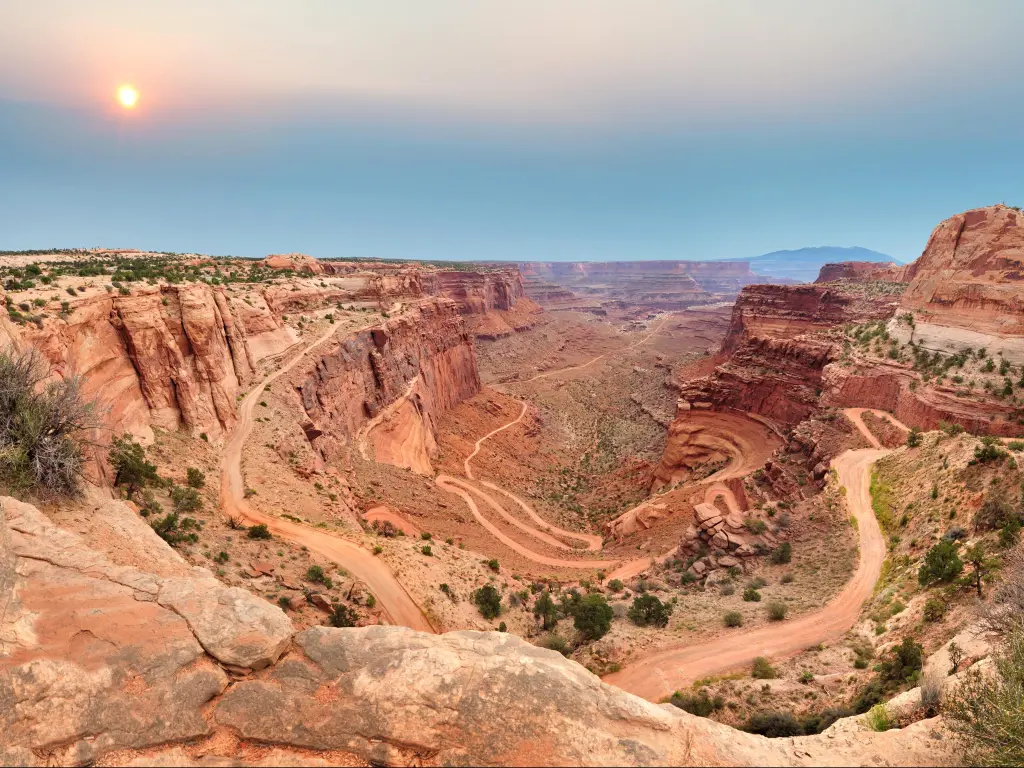
Why you should visit: Set in southeastern Utah is the Canyonlands National Park, a 12-hour drive from San Diego, a perfect park to visit while taking a trip to some of the other Utah national parks.
Segmented into four distinct regions, namely The Needles, The Maze, The Island in the Sky, and the Rivers, each has something different to explore and admire.
How to get there: The best way to get to Canyonlands National Park is via Interstate 15 North until you reach Utah and then following Interstate 70 East after passing by Dixie National Forest. Ultimately, you'll follow routes heading towards Moab, the closest town near the park.
Our highlights: Some of the top attractions of this sprawling desert landscape are the Mesa Arch (an orange-hued pothole arch made of sandstone), the most photographed part of the park, the Green River Overlook, and Grand View Point, which is famous for its sunset view.
You'll also get to explore Newspaper Rock which has one of the most extensive petroglyph anthologies in the world, and Horseshoe Canyon, which has one of the best hikes, terminates at a stunning overlook and is also home to a great rock mural collection.
The park is open to visitors all year; however, the best time to visit is either spring or fall since the temperatures are tolerable and the nights are pleasant.
In the winter, even though the day is bearable, as a desert landscape, the nights get terribly cold, so prepare accordingly if that's when you happen to go!
20. Redwood National Park, California
13 hours from San Diego (800 miles)
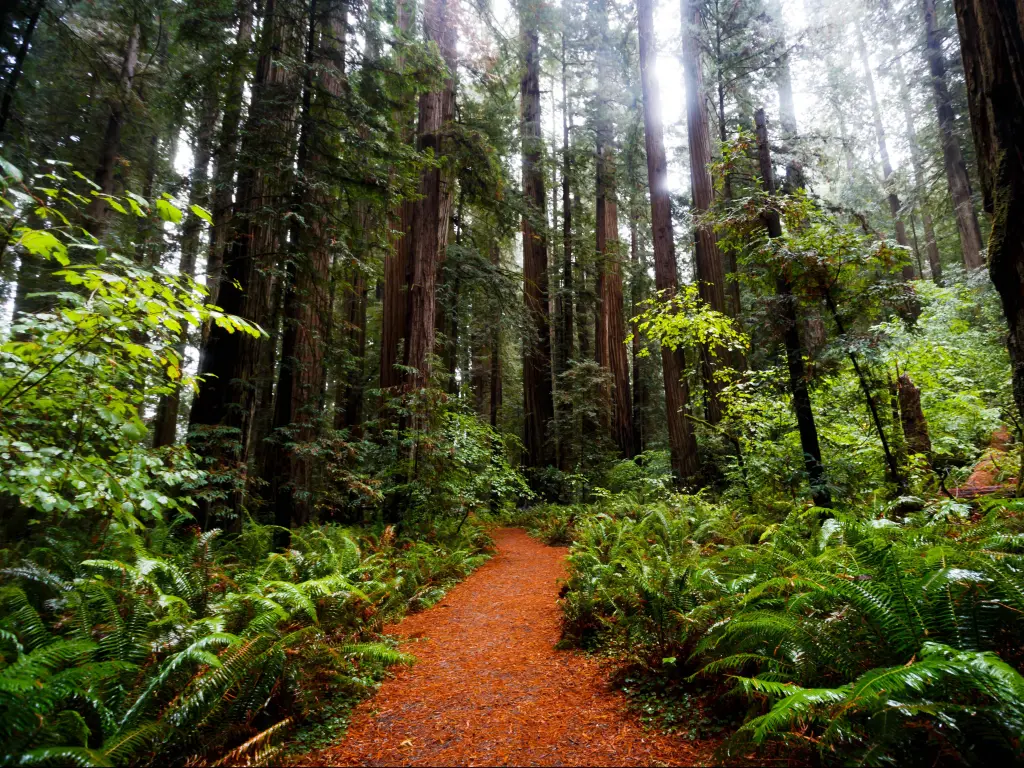
Why you should visit: Along the northern Californian coast is a patch of land with the world's tallest trees, called the Redwood National Park. Located exactly 800 miles from San Diego, this beautiful park is an excellent place for those looking for a place to be in solace.
The region has a rich cultural and ecological history and was designated as a UNESCO World Heritage Site and International Biosphere Reserve, driving more and more people to visit this magical place.
How to get there: The best route to get to this tranquil sanctuary is via Interstate 5 North. After around 500 miles, you'll reach San Francisco, where we'd recommend you utilize as a stopover point, with all this city has to offer.
From San Francisco, it's another 300 miles - taking US Route 101 North - until you reach Redwood National and State Parks. If your schedule allows, there is also plenty of opportunity to make short detours to enjoy the stunning Pacific coastline.
Our highlights: The park actually consists of a national park and some state parks, each with different landscapes and adventure excursions.
For instance, the Prairie Creek Redwoods State Park is known for Fern Canyon, with 30 feet-tall walls clad in ferns, and is inhabited by Roosevelt Elk that you'll spot if you spend some time camping in the Elk Prairie Campground.
The trees in the park are mighty old, ranging from 1000 to 4000 years, including the world's tallest tree, Hyperion, which is a 380 feet tall redwood tree.
Some activities that you can immerse yourself in during your visit are hiking (the forest has so many unique and scenic trails that are the epitome of calm mixed with adventure), camping at Gold Bluffs Beach with a view like no other, admiring the sunset at the Redwood Creek Overlook, and more, each bound to impress you.
Check out our recommended road trip from San Diego to San Francisco to see more attractions and stopovers you can enjoy.
21. Guadalupe Mountains National Park, Texas
12 hours 20 minutes from San Diego (830 miles)
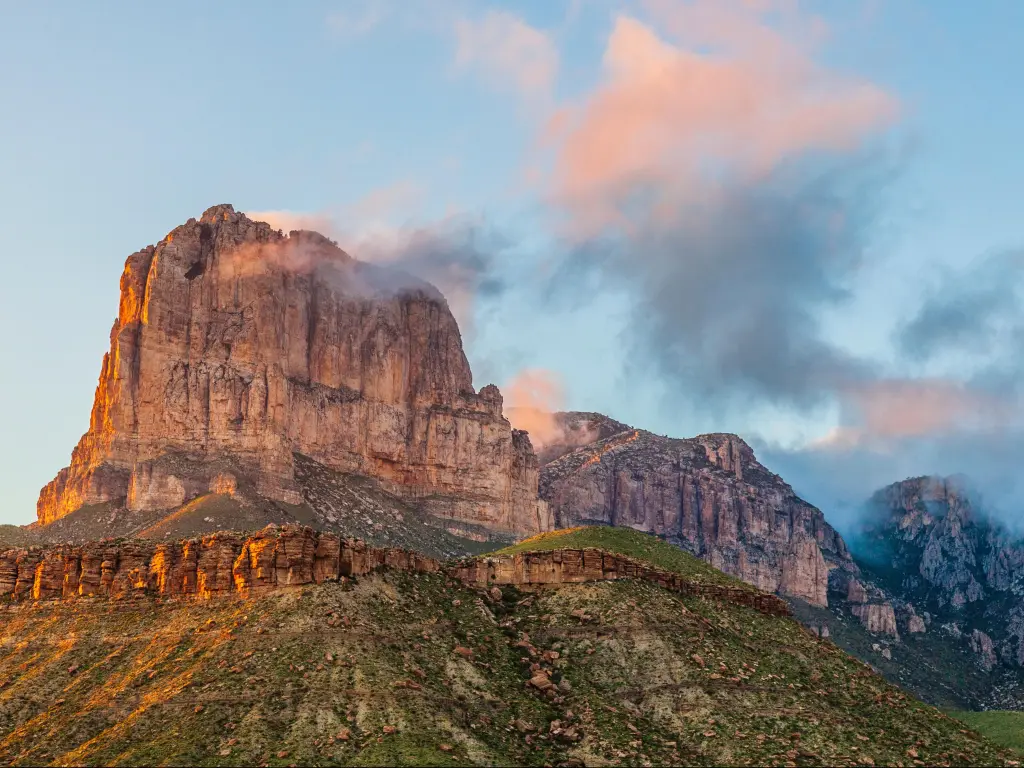
Why you should visit: Home to Guadalupe Peak, the highest point in all of Texas, the Guadalupe Mountains National Park. Situated 12 and a half hours from San Diego, this rather underrated park is worth a trip if you're searching for something more offbeat and secluded.
The park is home to the Guadalupe Mountains, which also extend into the Carlsbad Caverns National Park, Permian fossil reef, and lush Ponderosa Pine and Douglas Fir forests, giving it the nickname “America's best-kept secret".
How to get there: The easiest way to get here from San Diego is via Interstate 8 East to drive until the Arizona deserts before continuing onto Interstate 10 East just outside of Tucson.
The route will take you through small New Mexico towns before crossing over into Texas. Once you reach El Paso, you'll follow state routes (US-180 and then US-62) to get to the park's entrance.
Our highlights: It is believed that the stunning jagged cliffs that make up the mountains first became inhabited by Indigenous peoples and European settlers over 10,000 years ago.
Fast forward to 1978, due to their exploration and conservation efforts to ensure that the area's natural beauty was preserved, Congress designated it as a wilderness area.
Besides housing thousands of species of plants in the region, along with mammals like Mule Deer, Coyotes, and Mountain Lions, and up to 300 bird species, reptiles are abundant in the park. With perfect arid desert conditions, the region is populated by several snakes, including many rattlesnake species.
You can go on one of the park's several designated trails, camp at the Pine Springs Campground, run around the Salt Basin Dunes, admire the exhibits at Frijole Ranch History Museum, and so much more to enjoy an adventure-filled holiday in the Guadalupe Mountains.
22. Crater Lake National Park, Oregon
14 hours 30 minutes from San Diego (860 miles)
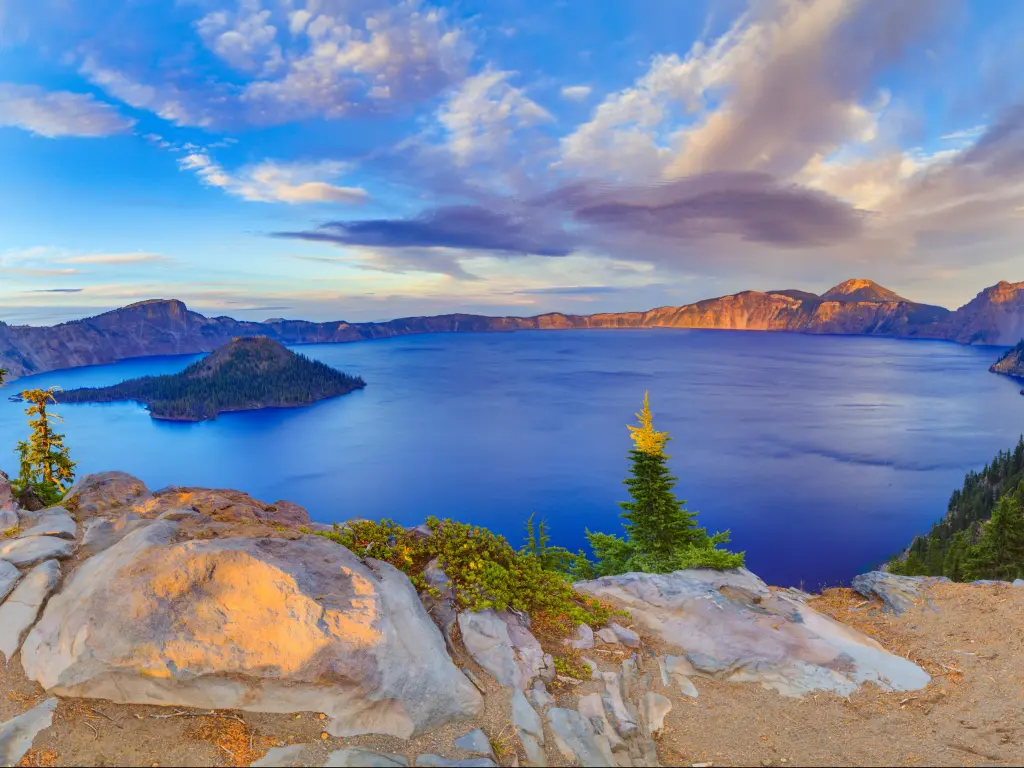
Why you should visit: Formed as a result of a fallen volcano, the Crater Lake National Park is one of the most scenic national parks in the country and takes up about a relatively small area of 183,224 acres in southern Oregon.
The views of the park are spectacular and well worth the drive - especially in the wintertime, as it is one of the snowiest places in the country.
How to get there: Located along a 14-and-a-half-hour drive from San Diego, the easiest route to Crater Lake National Park is via Interstate 15 North for the first part of your journey and then Interstate 580 heading towards Reno.
Reno a great place to stopover and spend the night since you'll have to divide the road trip into two to three days. After Reno, you'll pass back from Nevada into California via US Route 395 and follow state routes onward.
This last stretch of the route takes you through beautiful Plumas National Forest, Lassen National Forest, and Modoc National Forest as you enter Oregon before reaching the Crater Lake National Park.
Our highlights: The fall of Mount Mazama resulted from a volcanic eruption that took place 8,000 years ago, and then geological changes called in the area because of the explosion have led to the scenic park that Crater Lake is today.
The park is known as home to several wildlife species like Black Bears, Elk, Deer, Eagles, Hawks, and even Cougars (though Cougar sightings are very rare).
You can admire the park's numerous waterfalls, spend time by bubbling river streams, and run through the valley that is blooming with wildflowers in the springtime. The park is also one of the best to go biking on the trails to explore the different parts of the region.
23. Carlsbad Caverns National Park, New Mexico
12 hours 50 minutes from San Diego (865 miles)
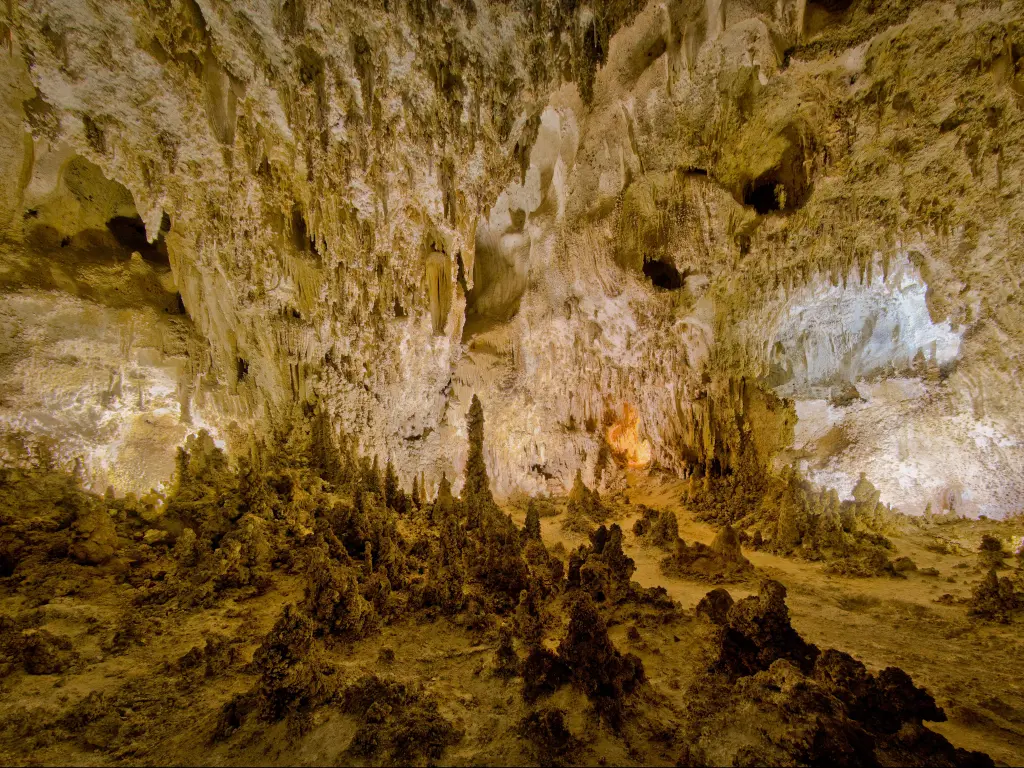
Why you should visit: Located 860 miles from San Diego and miles apart in terrain and landform is the Carlsbad Caverns National Park of southern New Mexico. With an exciting route and caves that will blow you away, a trip to this park is highly recommended.
The national park covers a total area of 46,766 acres and is known for its wildlife, rugged caves, jagged mountains (the Guadalupe Mountain Range extends into the park's boundary), and vast arid landscape that is home to several plant species.
How to get there: Though it's a long road journey away, you can quickly get to Carlsbad Caverns via Interstate 8 East until just outside Tucson and then exiting onto Interstate 10 East taking you straight to this haven of mystical caves.
Our highlights: The park's biggest attraction is its namesake cave, Carlsbad Cavern, a limestone chamber extending up to 4,000 feet in length and is the third-longest chamber in North America.
Besides this one, it is home to 120 other caves, each that were formed as a result of limestone dissolving in sulfuric acid, and newer passages continue to be discovered as time goes on.
Some of the park's attractions you mustn't miss out on are the Billy the Kid Museum, the Three Rivers Petroglyphs, ranger-led programs like the Night Sky Program, and of course, the caves - though remember to make a reservation for a tour in advance.
While exploring the area, you may also get lucky and spot a mule deer, mountain lions, Chihuahuan Desert pocket mouse and kangaroo rats.
24. Black Canyon of the Gunnison National Park, Colorado
13 hours 50 minutes from San Diego (900 miles)
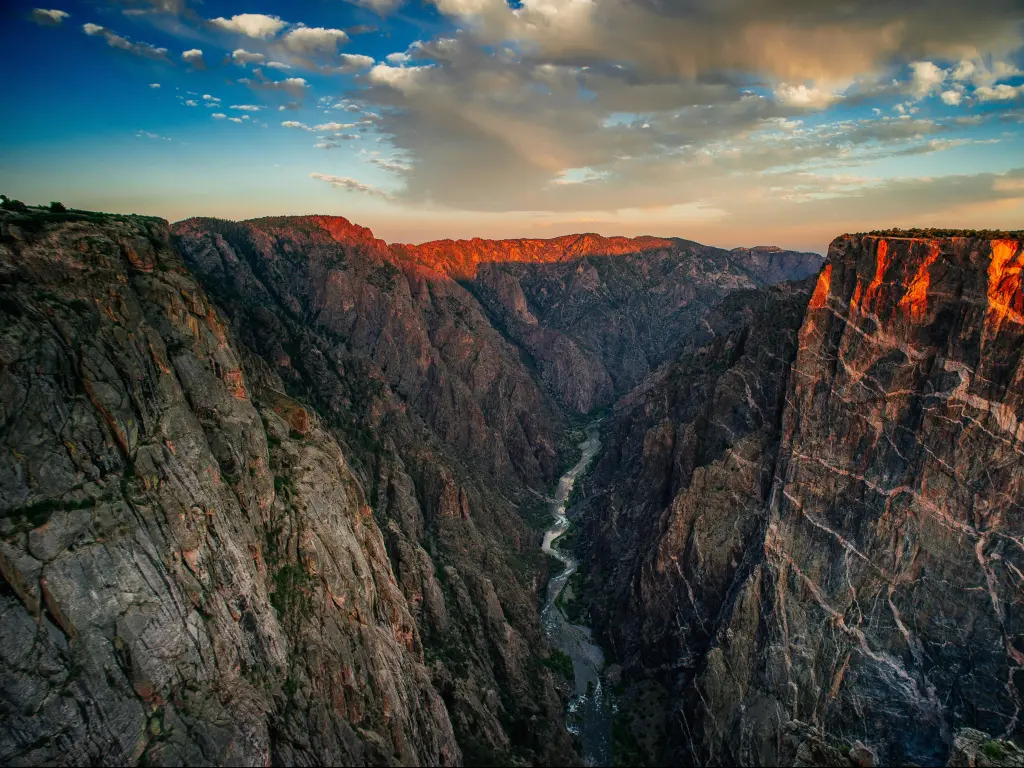
Why you should visit: Another quieter Colorado park is the Black Canyon of the Gunnison National Park.
Nicknamed “the Grand Canyon of Colorado,” the Black Canyon of the Gunnison National Park is known for its gray canyons that are believed to be carved by the Gunnison River - hence the park's name.
Black Canyon of the Gunnison National Park is blessed with fabulous scenic driving routes (South Rim Drive and North Rim Drive, just like the Grand Canyon), colorful sunsets, and unique hiking trails across the rather quaint 30,750 acres.
How to get there: you'll spend most of your trip on Interstate 15 North which will take you right from the desert of California through Arizona and into Utah. After crossing Dixie National Forest, you'll continue onto Interstate 70 East into Colorado and eventually the national park.
Our highlights: Formed as a result of two million years of ecological evolution and environmental change, this Western Colorado national park is perfect for a serene holiday devoid of big crowds and long queues.
If you're searching for a place with a scenic landscape but don't want to deal with crowds and worry about advance reservations, the Black Canyon of the Gunnison National Park is the place to be, especially in the autumn when the foliage turns red, orange, and yellow.
As an International Dark Sky Park that is rather isolated from big cities, the stargazing experience if you choose to camp a night is sure to be top-class.
25. Great Sand Dunes National Park, Colorado
15 hours 45 minutes from San Diego (955 miles)
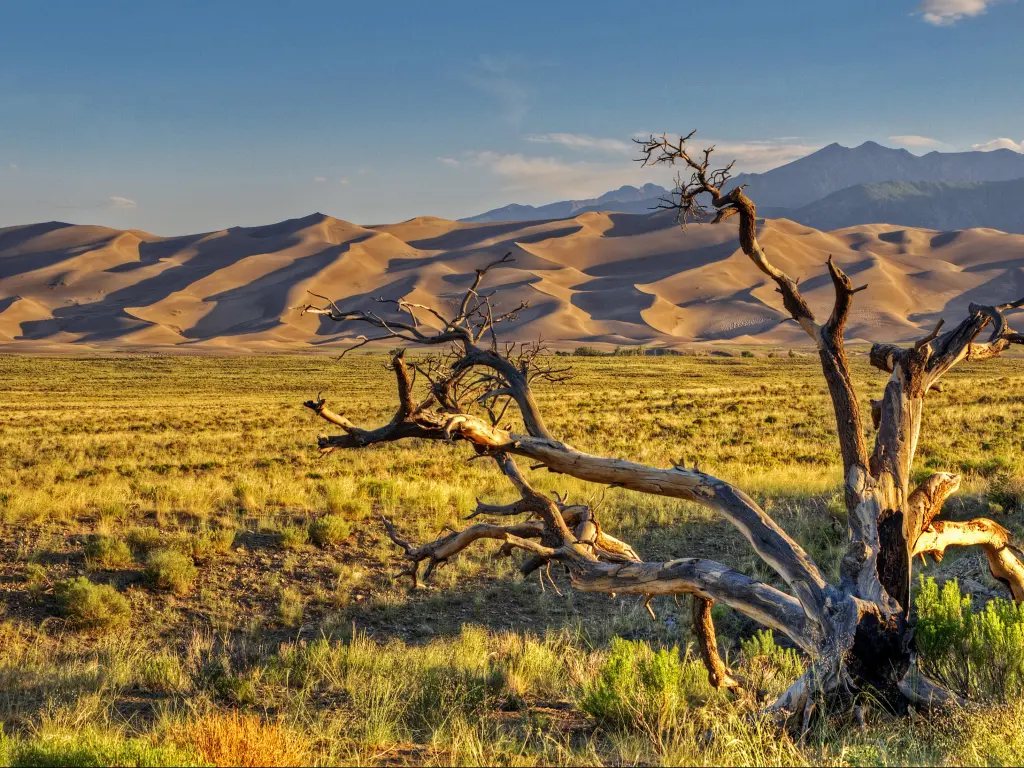
Why you should visit: Home to the tallest sand dunes in all of North America, accompanied by a variety of landforms, the Great Sand Dunes National Park is one of the most underrated national parks in the system.
Though it is located all the way in Southern Colorado, a pretty long way away from San Diego, a trip to Colorado is a must at least once, so you could make time for this national park when you do visit.
How to get there: The easiest way to complete the nearly 1000-mile journey is via Interstate 8 East to make it to Arizona and then follow state routes through Phoenix and the beautiful Tonto National Forest to ultimately get on Interstate 40 East to enter New Mexico.
You'll drive through the Navajo Nation Off-Reservation Trust Land and Jicarilla Apache Nation Reservation via state routes to make it to Colorado and the entrance to the park.
Our highlights: The park is mainly comprised of sand dunes that continue to change due to wind patterns, making the region a constantly evolving one.
You'll find pristine lakes (perfect for fishing - with a permit, of course), scenic drives, and of course the sand dunes, the tallest of which is the Star Dune, standing tall at over 750 feet.
There are many adventure activities at the park that you can partake in, like sandboarding and sledding down the dunes, hiking, going on a drive, fishing, and stargazing. Great Sand Dunes is a renowned International Dark Sky Park.
Owing to the unique geological nature of the area, with wind, minerals, and water coming together to give rise to the majestic dunes, you'll discover one-of-a-kind landforms and learn about how they've evolved with the changing climate.
You can combine this journey with our suggested road trip from San Diego to Denver for an even bigger adventure.
26. Grand Teton National Park, Wyoming
16 hours from San Diego (1,000 miles)
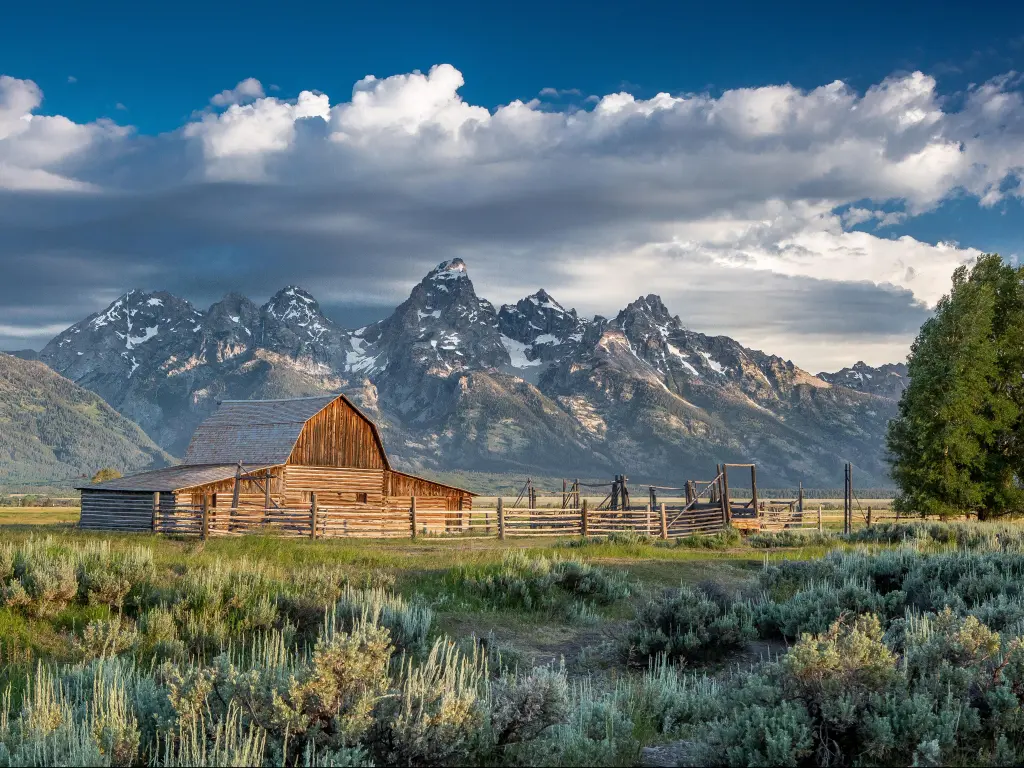
Why you should visit: Located a thousand miles away from San Diego is the magnificent Grand Teton National Park, one of the most visited parks in the system owing to its sweeping valleys, iconic sceneries, and overlooks that you cannot beat.
Known for being an amalgamation of wildflower meadows, pristine alpine lakes, jagged cliffs, and wildlife that roam about, Grand Teton National Park is genuinely paradise personified.
How to get there: To get there from San Diego, you'll have to spend most of your trip on Interstate 15 North driving from California through Nevada, Arizona, and Utah, where you'll continue onto US Route 189 North right outside of Salt Lake City.
Once you reach the Utah-Wyoming border, you'll have to follow state routes leading you to Jackson, the gateway town to Grand Teton.
Grand Teton and Yellowstone are within a stone's throw of each other (connected via the John D Rockefeller Parkway), so if you have a fortnight that you'd like to dedicate to exploring the beauty of Wyoming, why not take in both?
There's truly no better way to spend it than at these two parks, hiking, horseback riding, boating, and admiring the views.
Our highlights: There's so much to see in Grand Teton National Park that you'll want to keep going back. Our top choices include fishing in the clear blue lakes for some rainbow trout, hiking some of the most intricately designed trails in the system and catching the sunset from an overlook.
We suggest visiting in the autumn months above all, with the park is clad in fall foliage, and the sky turns pink and orange at dusk.
27. Rocky Mountain National Park, Colorado
16 hours 10 minutes from San Diego (1,045 miles)
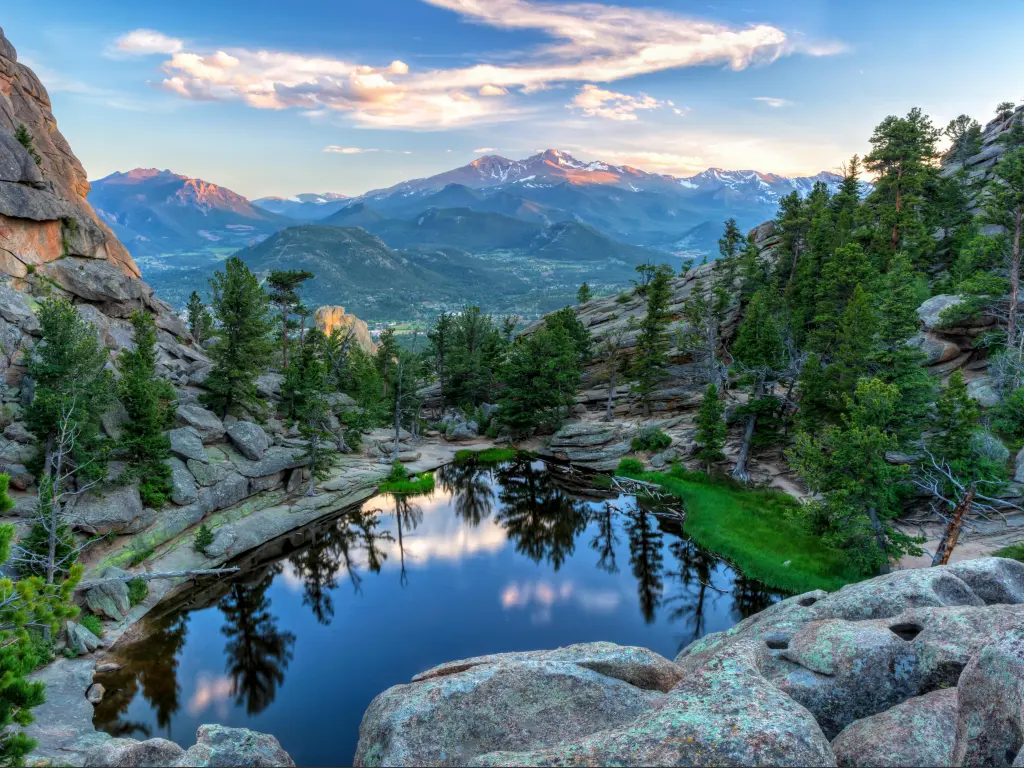
Why you should visit: It's no surprise that the Rocky Mountain National Park - located in Northern Colorado - is one of the most frequented parks in the US
With over 350 miles of hiking trails, several unique wildlife, countless alpine lakes, towering mountain peaks, and many other natural features, Rocky Mountain National Park truly has something for everyone.
How to get there: To get there, you'll spend most of your time on two Interstate roads, namely the Interstate 15 North from the city until you're well into Utah, from where you'll continue onto Interstate 70 East heading towards Denver.
In the last leg of your journey, you'll drive by quaint Colorado towns like Grand Junction, Glenwood Springs, and Vail (a famous resort destination during the ski season) before reaching your destination.
Our highlights: There's so much to see and do in the park, including driving on some of the most scenic byways in the National Park System, namely the Old Fall River Road and Trail Ridge Road, that promise unobstructed views of the forests, peaks, and rivers.
Despite being smaller than most famous parks in the country, the park has plenty to explore, like Long's Peak, the highest peak in the Northern front range of the Rocky Mountains of North America.
As one of the highest altitude parks in the US, one of the most pictured parts of the region are naturally the breathtaking mountainous lakes, the most famous of which is Bear Lake, located at 10,000 feet and reachable by a beginner-friendly half-mile hike.
You can also explore Grand Lake, which is the state's largest and deepest lake. The lakes are also accompanied by stunning waterfalls (that you can get to via following short trails), the most beautiful of which are the Thunder Falls, Alberta Falls, and Glacier Falls.
The park is a hotspot for wildlife viewing, especially if you're looking to spot some Elk (there's a different kind of Rocky Mountain elk, only found in the park's area), Bighorn sheep, moose, black bears and mule deer.
Though it looks like a postcard during most parts of the year, if you happen to visit in the winter (you may need special permits), you'll get to explore snow-covered peaks and frozen pristine lakes that will take your breath away.
If you are visiting Rocky Mountain National Park, keep in mind that the national park uses a timed entry permit system. Please check the national park's website to see if you need to make a reservation before your visit.
28. Big Bend National Park, Texas
16 hours 10 minutes from San Diego (1,050 miles)
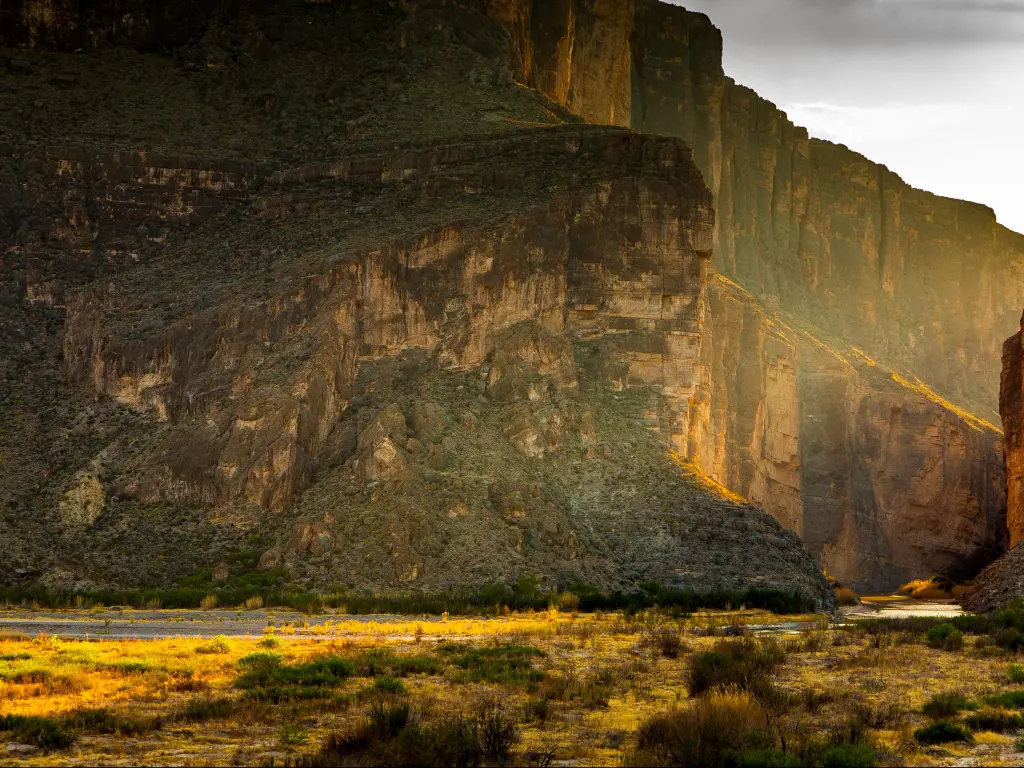
Why you should visit: An oasis in southwestern Texas, the Big Bend National Park is a diverse region with so much natural beauty to offer. As a result of the varying elevation, the park is inhabited by over 450 species of birds, several mammals and reptile species, and over a thousand different plant species.
Though located over a thousand miles from San Diego, you could combine your trip to a couple of Texan national parks into one big adventure to make the drive even more worthwhile.
How to get there: To get there, you'll follow along Interstate 8 East into Arizona until outside of Tucson, where you'll exit onto Interstate 10 East which will take you through small New Mexico towns (including Las Cruces, the gateway town into the White Sands National Park) before entering Texas, home to the park.
Our highlights: The park takes up over 800,000 acres and is known for several things, the most prominent of which is the difference in elevation within the park (the lowest point is at the Rio Grande River at 1,715 feet, and the highest is 7,832 feet at the summit of Emory Peak).
Besides being an admirable natural feature, the Rio Grande River acts as a boundary to the park and the border between the US and Mexico. There exists a bend in the river, leading to the name of the park.
Not to be missed is the Ross Maxwell Scenic Drive, as well as Langford Hot Spring, and Santa Elena Canyon (where you can go boating in the Rio Grande River to enjoy scenic views, though, since it might extend onto international territory, you'll need a passport).
Not only is Big Bend an International Dark Sky Park, but the region, because of mainly being barren and desolate, has one of the darkest skies in the lower 48 states, making the stargazing experience genuinely unreal!
29. Yellowstone National Park, Wyoming
15 hours 40 minutes from San Diego (1,070 miles)
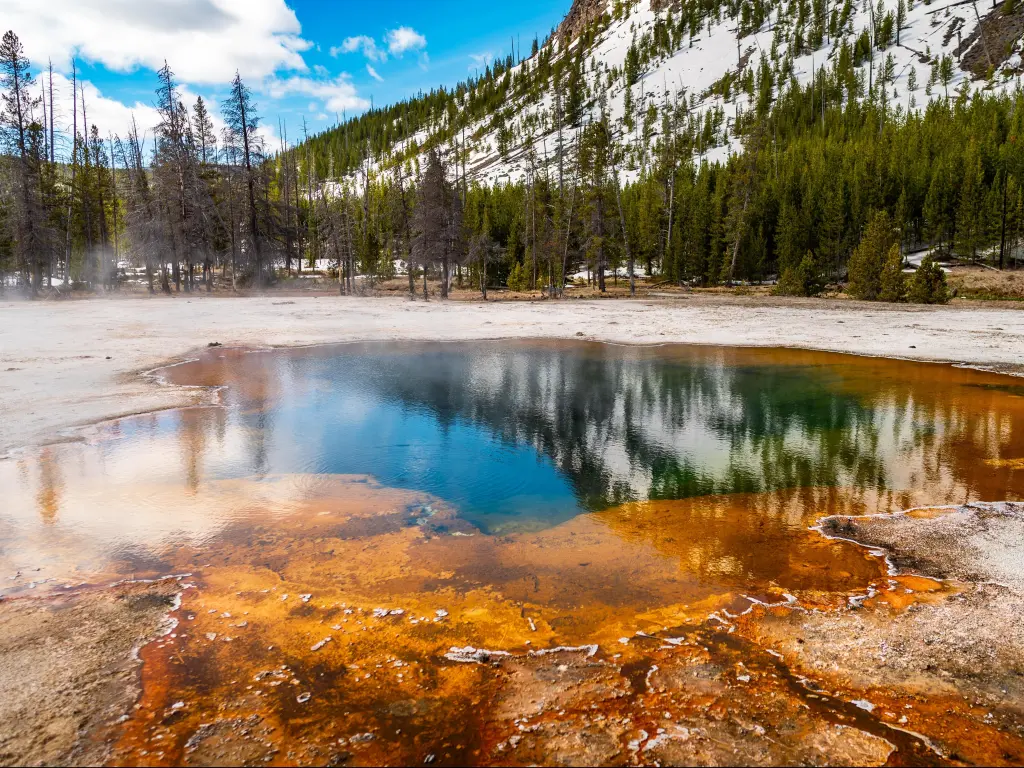
Why you should visit: Spread across a colossal area of 2.2 million acres with countless hydrothermal features, waterfalls, archaeological sites, scenic overlooks, and so much more, the Yellowstone National Park is undoubtedly one of the most famous national parks in the world.
The region is home to over five hundred active geysers - accounting for over half of the geysers in the world - and a variety of other hydrothermal attractions like hot springs and mud pots, the most famous of which are the Old Faithful Geyser.
How to get there: Located over 1,000 miles by road from San Diego, if there's any place worth driving this much for, it is the Yellowstone National Park, located primarily in Wyoming, though regions extend over borders into Idaho and Montana.
The easiest way to get to this natural paradise is via Interstate 15 North which will be the road to follow for most of your journey. You could break the drive into two or three days, stopover in Las Vegas or Salt Lake City for a night, and even club visiting Yellowstone with a trip to the Grand Teton National Park, which is located in the same region.
Our highlights: Old Faithful Geyser was the world's first geyser to be named - with a highly appropriate name, as= it is believed to erupt in regular intervals.
In addition to Old Faithful, be sure to check out the Steamboat Geyser which is currently the world's tallest active geyser, extending up to 400 feet tall eruptions.
Amongst all these iconic landscapes, several animals, including Grizzly Bears, Black Bears, Bison, and Wolves, call this massive patch of land home. You'll also spot several endangered birds, amphibians, and reptiles, each having adapted to the region's unique topography to survive.
With over 1,000 miles worth of hiking trails, the largest high-elevation lake in North America (Yellowstone Lake), and magnificent waterfalls, a trip to Yellowstone is bound to be a dream.
Check out our ultimate guide for a road trip from San Diego to Yellowstone National Park to make the most of your time on your journey.
READ MORE - Road Trip from San Diego to Yellowstone National Park
30. Mount Rainier National Park, Washington
19 hours 30 minutes from San Diego (1,220 miles)
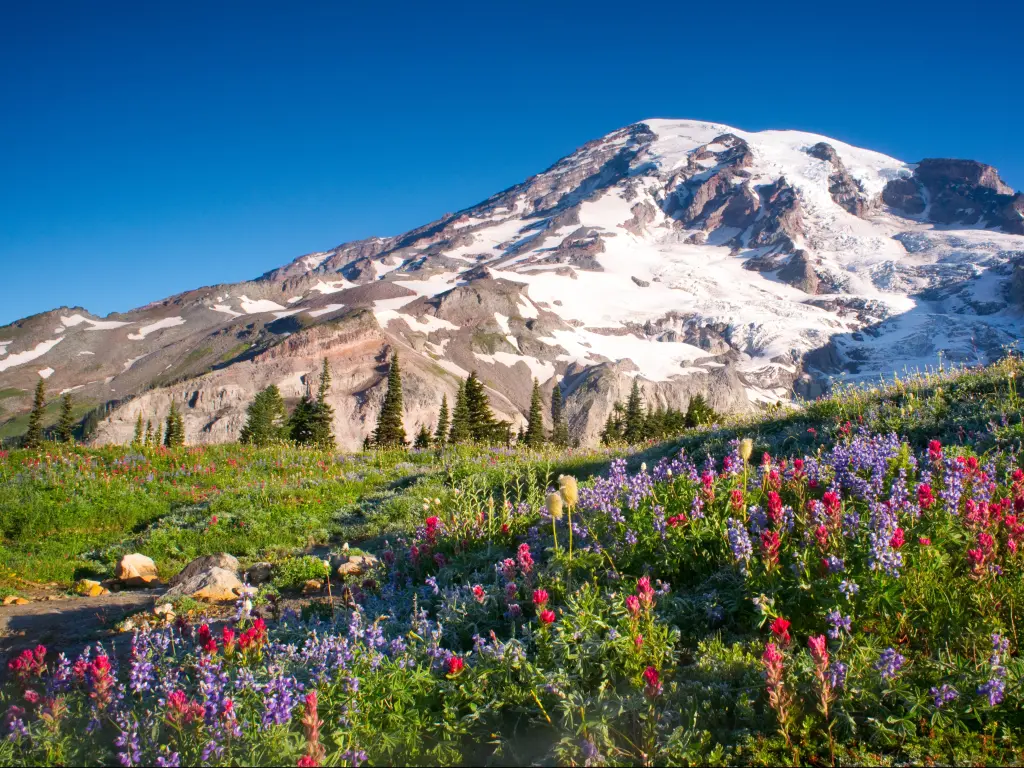
Why you should visit: One of the oldest national parks in the system, Mount Rainer National Park, located outside of Tacoma in Washington state, is truly a piece of heaven.
One of the snowiest places on earth, the scenery is picture-perfect no matter what time of year you visit, though in the spring and early summertime, you'll be able to spot the beautiful valleys blooming with wildflowers.
How to get there: Mount Ranier is located a long way away from San Diego - about a 20-hour drive to be exact. If you have a week to explore and an adventurer's soul to feed, though, the trip is bound to be worth the effort.
The easiest way to get there is via Interstate 5 North along the California coast through Oregon and into Washington. It's recommended that you break up the trip into a couple of days, and you can stop over in San Jose and Portland to spend the nights.
Our highlights: Spread across 236,381 acres, Mount Rainer is the center of this magnificent landscape, standing tall at 14,410 feet. It's an active volcano that is actually the most glaciated peak in the lower 48 states.
Though it is a snow-clad peak during most parts of the year, it is a stratovolcano (generally steep peaks with a summit crater and frequent eruptions) and thus can erupt again.
Be sure to explore Reflection Lake, the Wonderland Trail (a 93-mile loop trail that traverses around Mount Rainer, a thrill-seeking adventure for expert hikers), White River Campground (set at an elevation of 6,400 feet, the highest drivable point in the park).
The park is home to several unique wildlife species, including the infamous Black Bears, who mostly emerge once the peak of winter weather begins to plateau.
Whether you're looking for a natural haven to reconnect with yourself amidst the fall foliage or go rock-climbing with your friends in the summertime, Mount Rainer National Park is sure to be nothing short of beautiful.
Best National Monuments, State Parks, National Conservation Areas and Preserves
Besides national parks, you'll also find several monuments, forests, and recreational areas within proximity of San Diego that are better for day trips and short excursions.
These natural wonders may involve shorter drives - but that definitely doesn't mean less excitement!
1. Cuyamaca Rancho State Park
45 minutes from San Diego (45 miles)
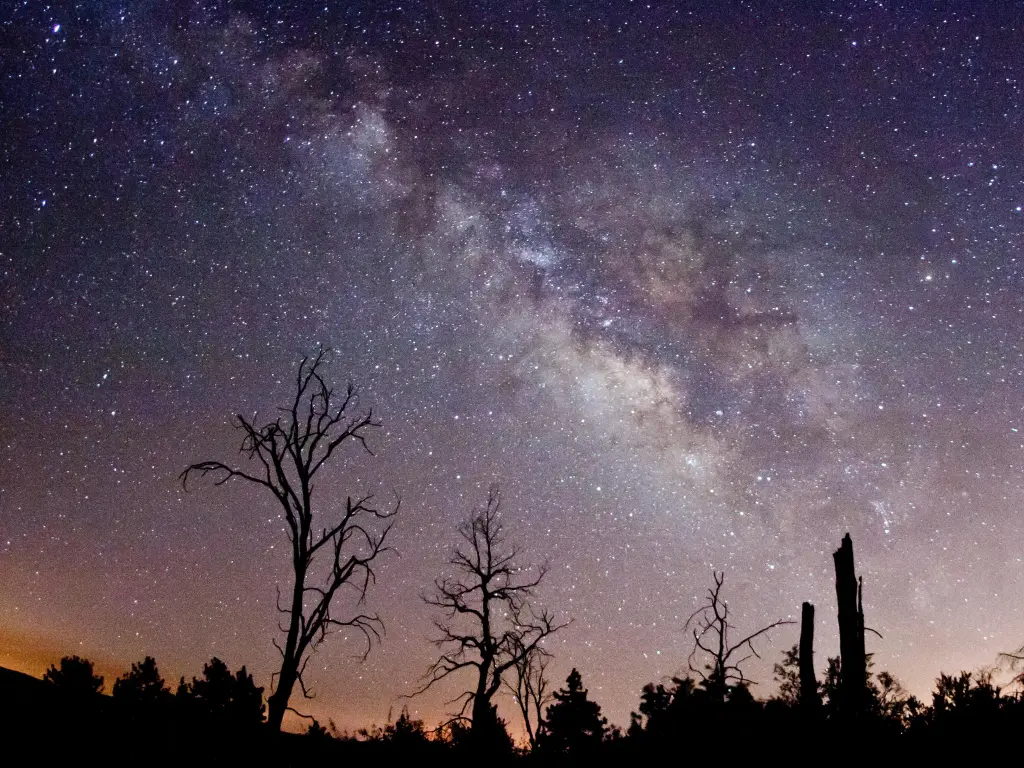
Situated less than an hour's drive away in the Cuyamaca and Laguna Mountains is the Cuyamaca Rancho State Park. Spread across 26,000 acres, it houses several different plant species, including the evergreen pine, oak, and fir trees.
Interstate 8 East will lead you from the city center to this oasis of woodland forests and wildflower valleys.
Within the park, you'll find over 100 miles of trails, perfect for hikers or horseback riders, camping grounds (Paso Picacho and Green Valley), sprawling valleys, and meadows with bubbling creeks. The park houses the towering Cuyamaca Peak (6,512 feet), a large Mountain Lion population amongst several other mammals, reptiles, and birds.
The region has a rich history of being the home of indigenous peoples in the early ages, whose legacy lives on in the many marks around the park, including the Cuyamaca complex archaeological site.
This state park is a short drive from the city center and is great for a hike, an autumn picnic with friends, or horseback riding in the valley.
2. Cleveland National Forest
1 hour 20 minutes from San Diego (45 miles)
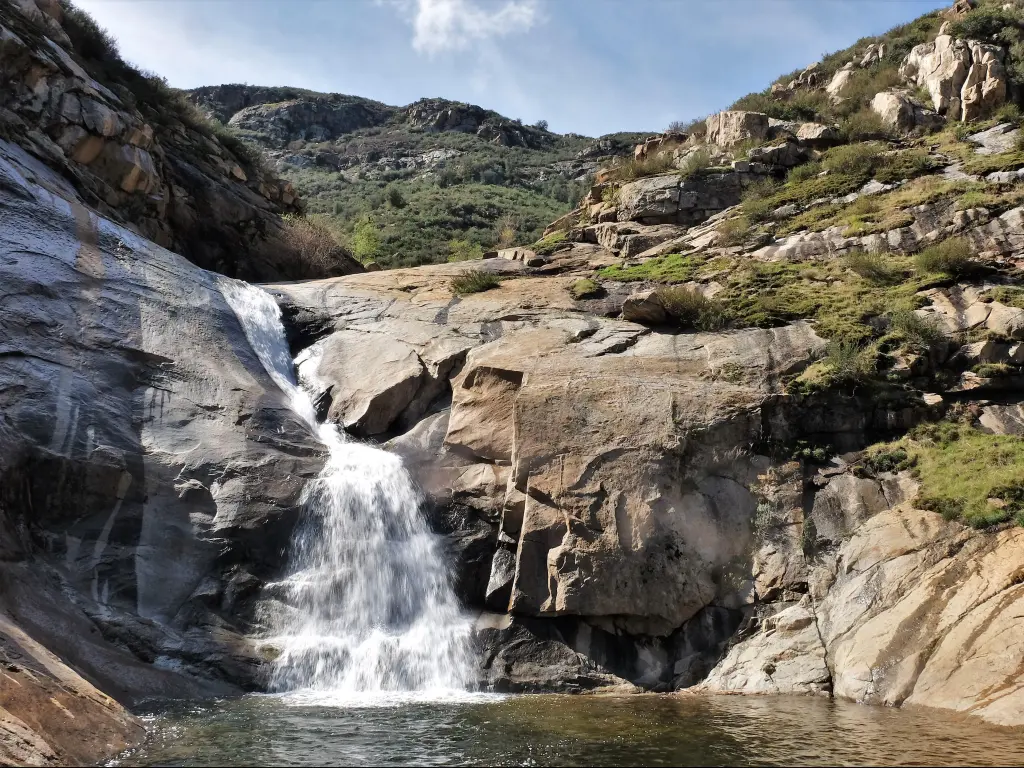
Located less than 50 miles from San Diego, the Cleveland National Forest is the southern-most National Forest in California. Comprising a large area of 460,000 acres, this forest is a tranquil patch of land, home to various plants and animals.
With over 350 miles of hiking trails and peaks that go up to 6,000 feet in elevation, it's the perfect place to catch a break from the fast-paced SoCal lifestyle! In addition, there are also numerous campgrounds, fishing lakes, and scenic byways (including the Sunrise National Scenic Byway).
You can go hunting, mountain biking, 4x4 adventure riding, hiking, fishing and camping, to make the most of the diverse climates and landforms that make up the iconic Cleveland National Forest.
3. Sunrise National Scenic Byway
1 hour 10 minutes from San Diego (60 miles)
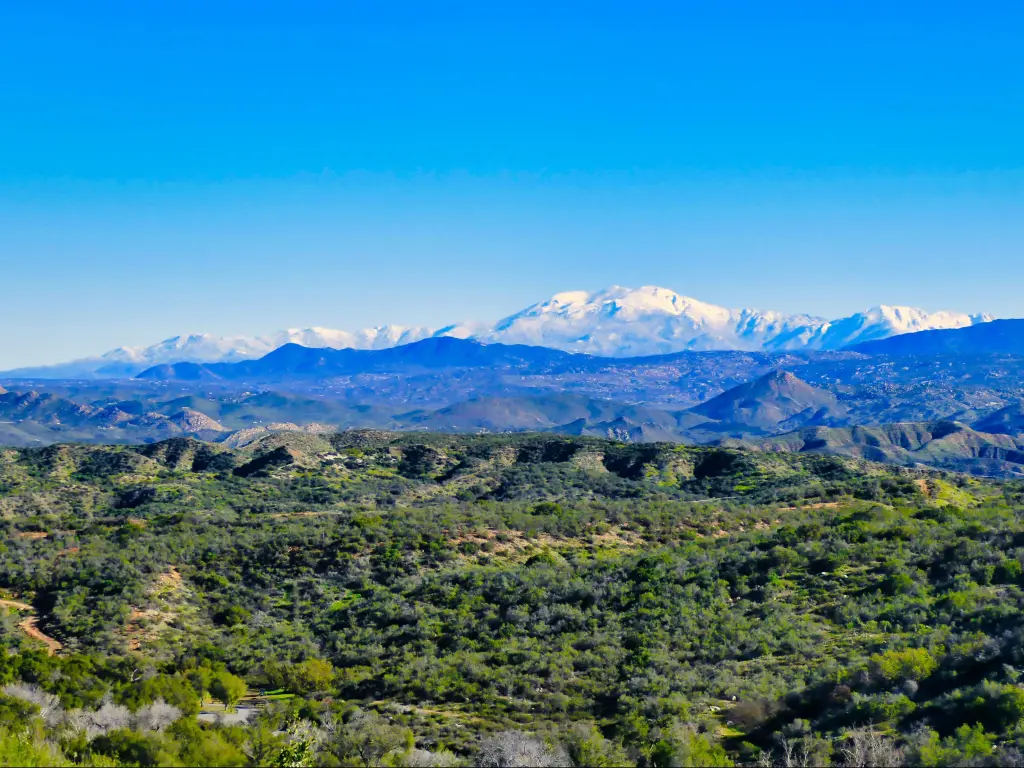
If you're searching for a quick day trip activity away from San Diego, there's virtually no place closer and better than the Sunrise National Scenic Byway. The scenic drive begins at the cross-section of Interstate 8 with County Road S1 and extends well beyond the beautiful laguna Mountain Recreational Area.
To get to this route, you'll get on Interstate 8 East, which will lead you to the drive itself. You'll spot panoramic views of the Recreational Area, Cleveland National Forest and mountain valleys.
Extending over 24 miles, it is a perfect place to visit on a spring afternoon for a picnic with friends or a romantic drive with your partner amidst the fall leaves. You can spot along the way to really take in the stunning mountain meadow views.
Since the route is through the Cleveland National Forest, you'll also be able to stop at trailheads, like the Pioneer Mail trailhead, to take a hike and explore the region's natural beauty.
4. Anza-Borrego Desert State Park
1 hour 30 minutes from San Diego (75 miles)
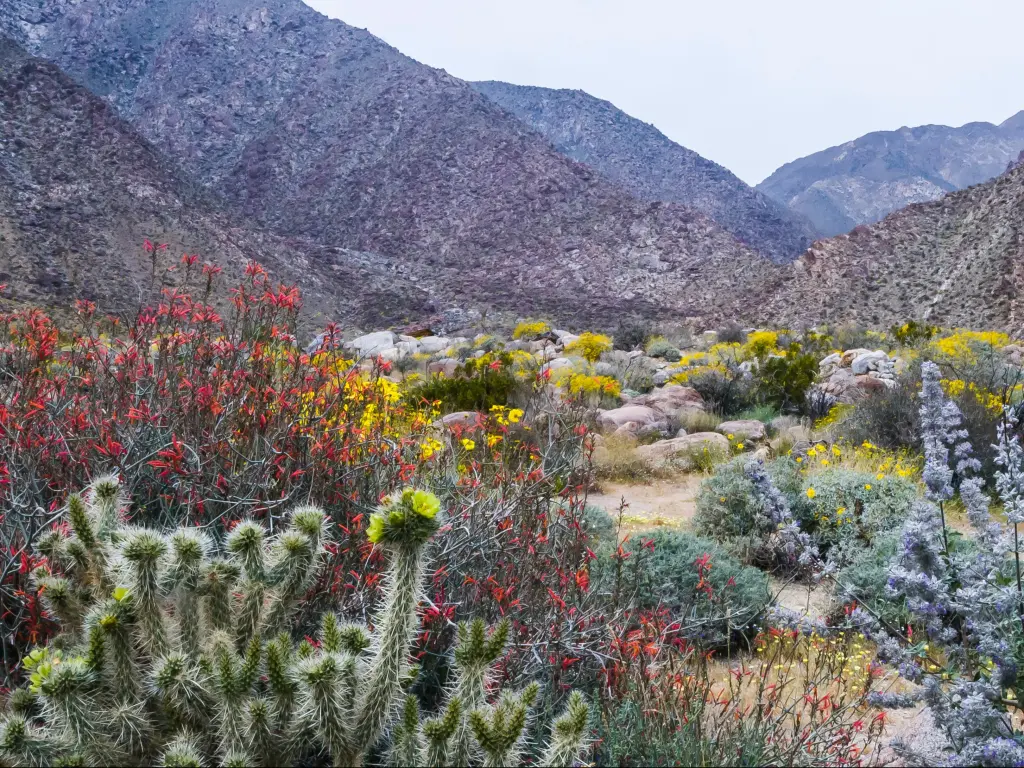
The biggest state park in California, the Anza-Borrego Desert State Park, is located an hour and a half from San Diego on the ancient home of the Cocopah people.
To get to this massive park (it spreads across 585,930 acres), you'll follow Interstate 8 East and California Route 79 North. At the park's visitor center, you'll find well-designed exhibits that house information about the terrain and pay homage to its past inhabitants.
The state park is named after Juan Bautista de Anza, a Spanish explorer that was a pioneer in surveying and documenting this region, and “Borrego,” which is the Spanish word for sheep, referring to the park's enormous population of Bighorn Sheep.
With cacti-lined hills, jagged mountains, vast desert landscapes, and more, a couple of hours spent at the Anza-Borrego Desert State Park are sure to be peaceful. Bonus: It is an International Dark Sky Park, so be sure to stay until the evenings and grab blankets and snacks as you stargaze.
5. San Bernardino National Forest
1 hour 30 minutes from San Diego (100 miles)
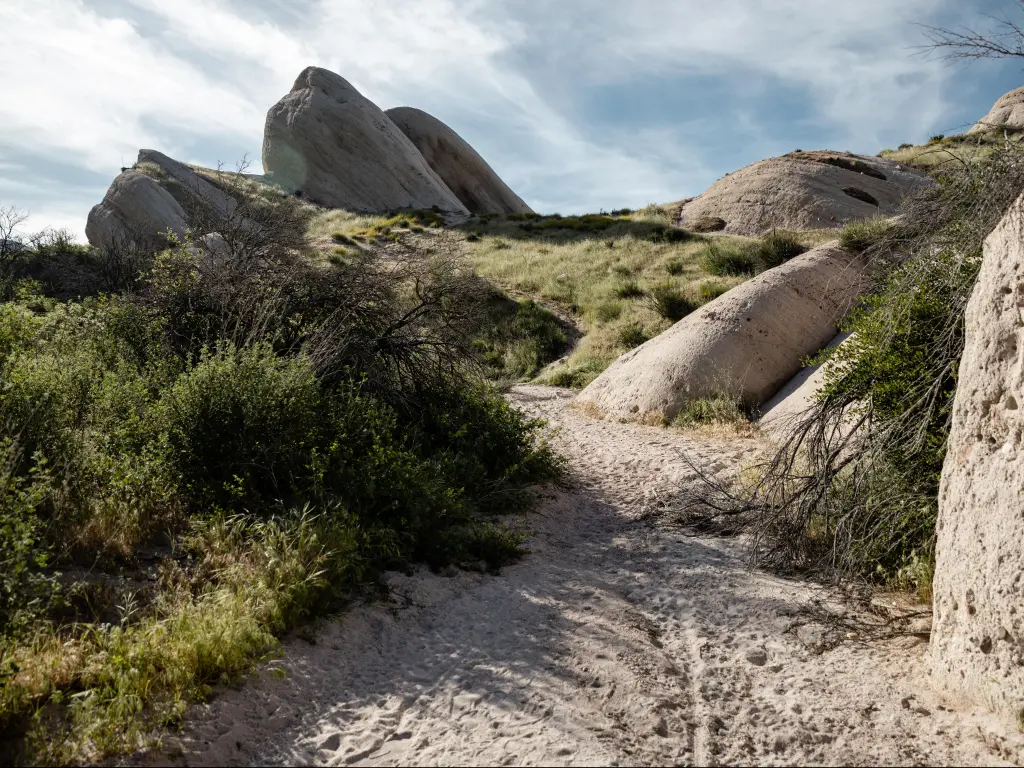
Located just short of 100 miles by road from San Diego is the expansive San Bernardino National Forest. Home to four mountain ranges and several wilderness preserves within its 800,000 acres, it is an excellent place for hikers or boating aficionados.
A short hour and a half drive from the city, the best way to get there is via Interstate 15 North and Interstate 215 North. To make the most of this vast region, you can go boating in the water bodies, climbing, hiking, and skiing in the winter months.
With proximity to the resort town of Big Bear, the region also has several ski resorts ideal for a wintertime getaway.
Spread across 823,816 acres, the San Bernardino National Forest is home to Bighorn Sheep, Peregrine Falcons (which are not only the world's fastest bird but also overall the fastest animal due to their impeccable diving speed of 186 miles an hour), Bald Eagles, and several plan species.
A diverse landscape housing different flora and fauna as well as scenic overlooks, the San Bernardino National Forest is definitely worth a visit.
6. Santa Rosa and San Jacinto Mountains National Monument
2 hours 10 minutes from San Diego (115 miles)
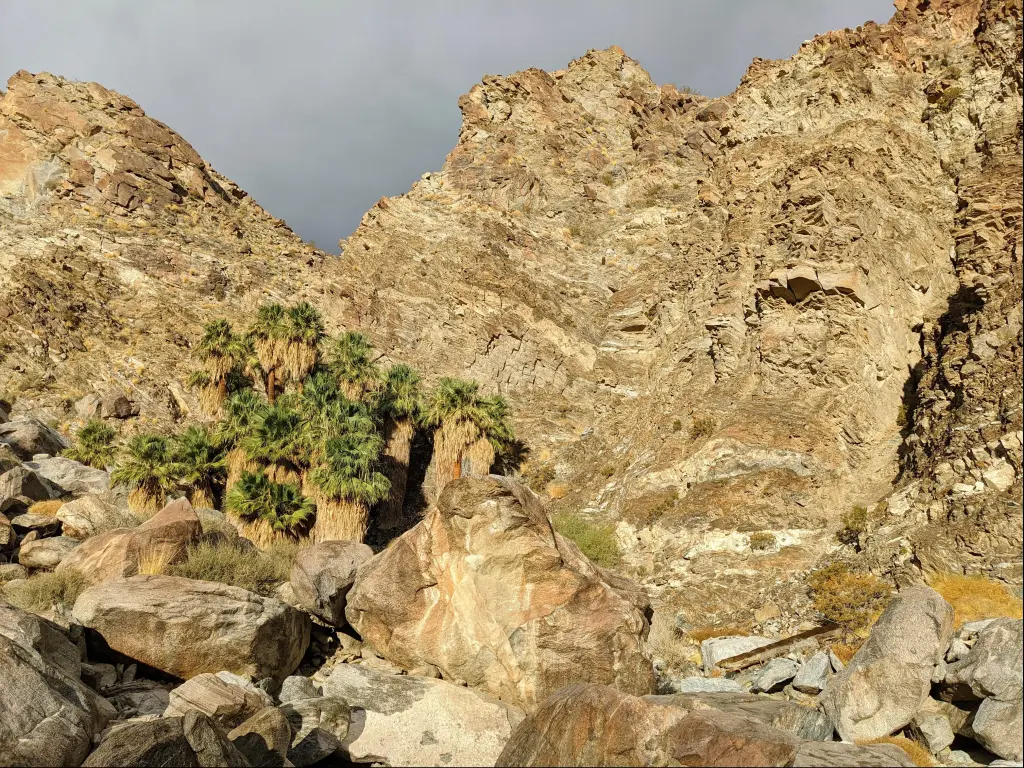
Situated over 100 miles from San Diego city is this one-of-a-kind national monument called Santa Rosa and San Jacinto Mountains National Monument! To get here, all you need to do is get on Interstate 15 North and merge with local state routes to ultimately make it to your destination.
The picturesque mountain ranges have peaks that reach up to 10,834 feet and provide the infamous backdrop to the Coachella Valley. The monument comprises two Federal conservation areas - the Santa Rosa region and the San Jacinto region.
At the monument, you'll be able to enjoy beautiful scenic trails, wilderness preserves that are inhabited by different plant and animal species, snow-clad peaks in the height of winter, and several other distinctive destinations, each more peaceful and scenic than the next.
There are several camping spots spread across the monument, making it perfect for spending a stargazing night.
7. Santa Monica Mountains National Recreation Area
2 hours 30 minutes from San Diego (155 miles)
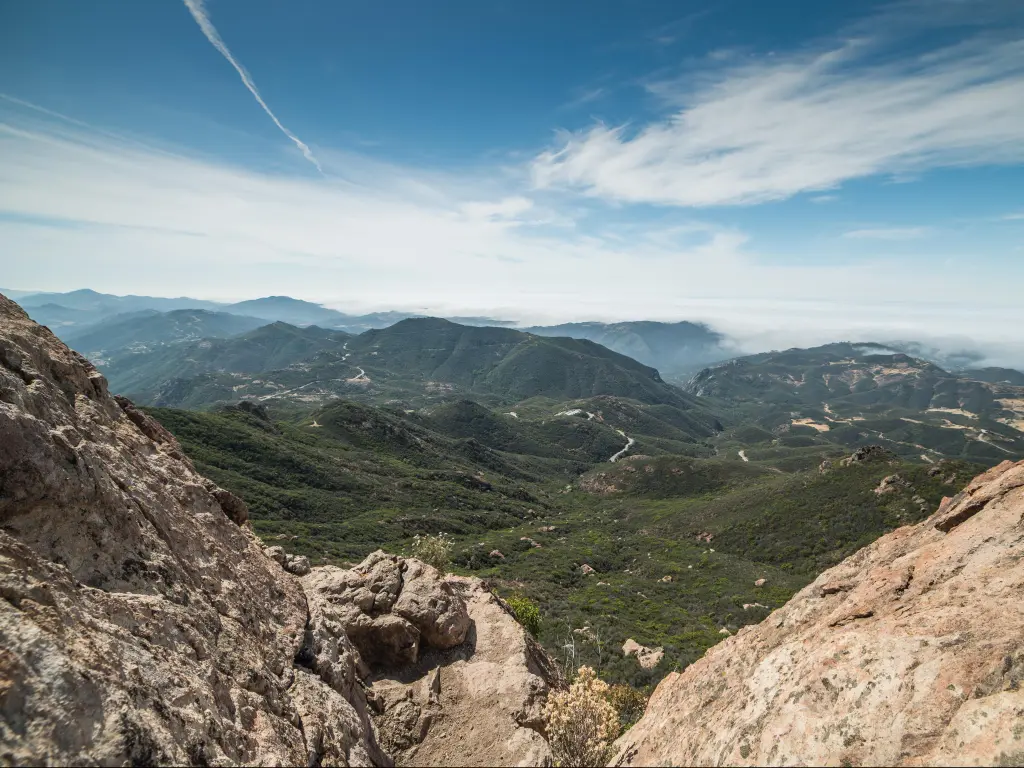
Located over 150 miles away from the city is the sweeping Santa Monica Mountains National Recreation Area. The mountain range has hills ranging from 1,000 feet tall up to 3,000 feet tall.
To get there, you'll get a chance to drive along the beautiful California coast via Interstate 5 north until getting onto California Route 73 North after Huntington Beach. Ultimately, you'll follow Interstate 405 North to avoid Los Angeles traffic and get to the park in time about two-and-a-half hours.
Spread across 157,700 acres, it is the largest urban national recreation area in the United States and houses several distinct parks and open preservation regions.
This is a vast region full of diverse landscapes like the Malibu beaches, the celebrity locality of Calabasas, multiple state parks, and unique animal species like the Mountain Lions - Los Angeles is one of the only two megacities in the world that has any form of a big cat living in such close proximity to it.
If you're yearning for a challenge, the Backbone Trail extends for 67 miles from the east end of the mountains to the west.
8. Kofa National Wildlife Refuge
3 hours 45 minutes from San Diego (225 miles)
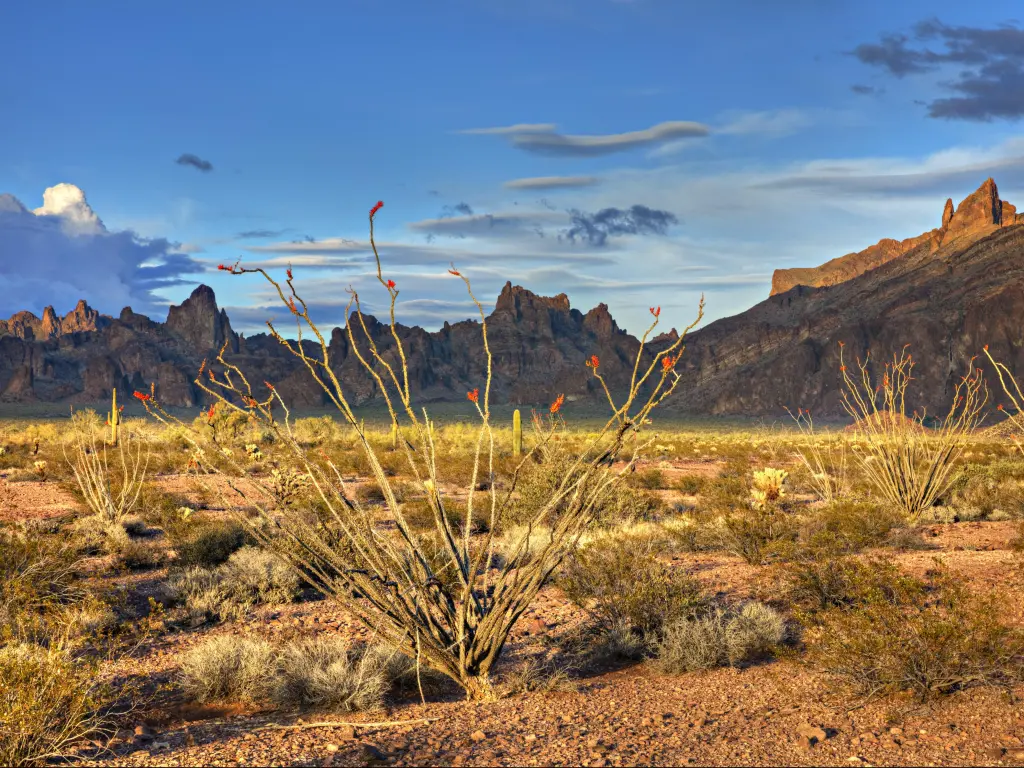
Encompassing 665,400 acres in Southwestern Arizona is the Kofa National Wildlife Refuge. Home to desert Bighorn sheep (found mainly in the Kofa and Castle Dome Mountains) and other small animals like tortoises, kit fox, and badgers, it is a serene oasis of jagged mountains and valleys.
Located over 220 miles from the city, you'll drive through the arid California regions via Interstate 8 East to get to Kofa National Wildlife Refuge.
Though it is a wildlife refuge and is mostly known for conserving various plant and animal species, uniquely, the region has also become famous for the quartz crystals that visitors can find at Crystal Hill.
The area has only one marked trail called the Palm Canyon Trail (7.1-mile-long loop) and several other places to walk, explore, and forage through.
9. Mojave National Preserve
3 hours 45 minutes from San Diego (240 miles)
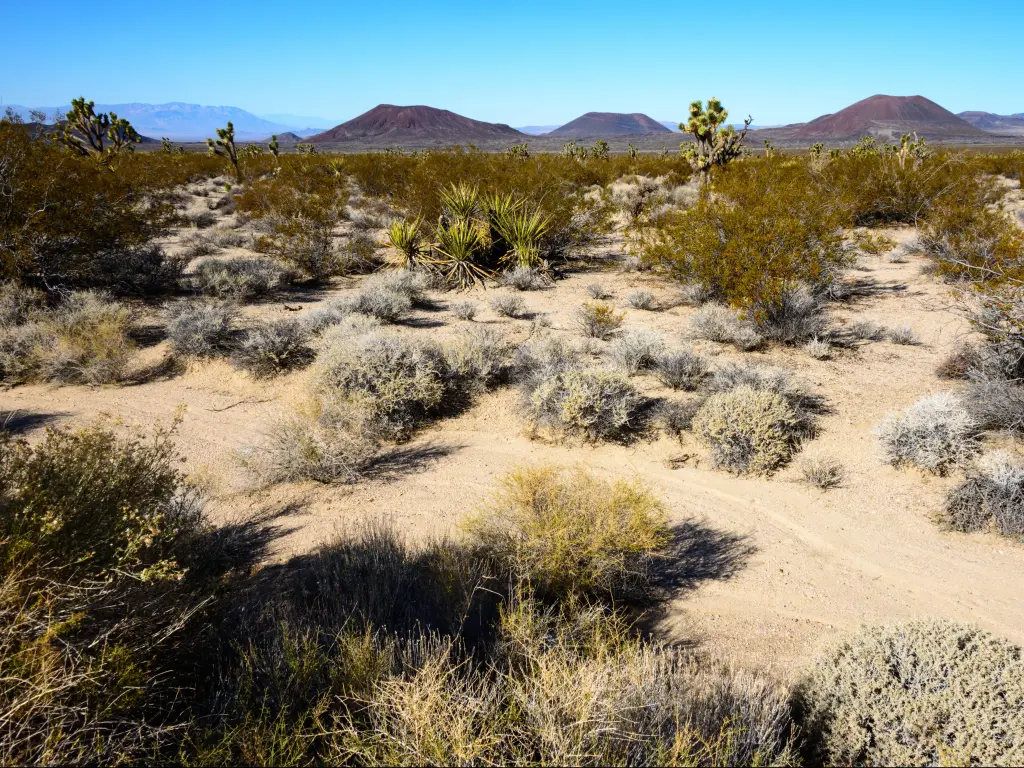
A massive 1.6-million-acre region, the Mojave National Preserve located in Southern California was established as a national preserve in 1994.
The area is known for its spectacular desert views, rugged peaks (the region includes three major mountain ranges), towering sand dunes, valleys (packed with wildflowers in the springtime), and so much more.
Located a short 4-hour drive from the city, it's great for a day trip if you begin your journey in the early hours of the day. The best route to the preserve is via Interstate 15 North and Interstate 215 North, though alternatively, you could also follow state routes if you wish to drive through the Joshua Tree National Park.
The elevation in the region ranges from 800 feet with the now dry lake beds and goes up to 8,000 feet due to the peaks in the area. You'll find the Kelso Dunes, which stand tall at 600 feet, the Cima Dome populated with Joshua Trees, now dormant volcanoes and rugged canyons.
You can explore the sights of the area via hikes, camping, scenic, horseback riding, four-wheel driving, and biking, and if you get lucky, you might spot a Coyote, Mountain Lion, or Bighorn Sheep.
10. Los Padres National Forest
6 hours from San Diego (275 miles)
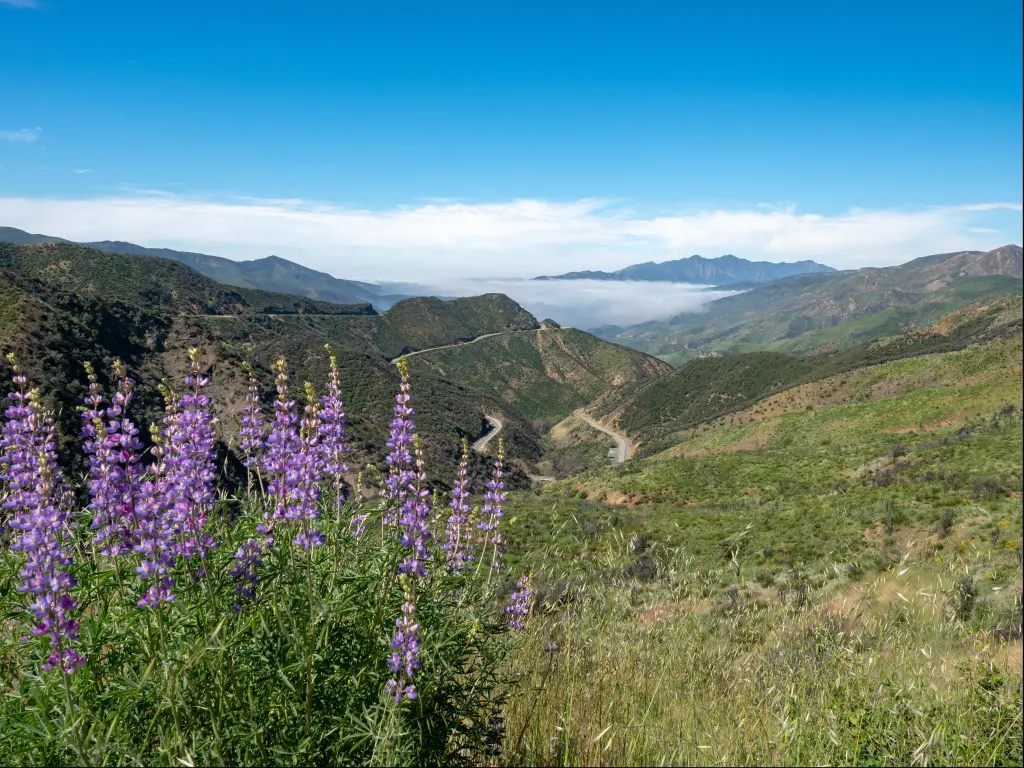
Occupying up to 1.75 million acres of central California's breathtaking coast is the Los Padres National Forest. It includes many of California's top attractions, divided into the Northern and Southern divisions.
From San Diego, you'll be able to quickly get to Los Padres National Forest by following the same route up until the Santa Monica Mountains National Recreation Area and then after crossing Ventura (the town where you can take a ferry to visit the Channel Islands National Park) you'll get on US Route 101 North to get to this massive forest.
Home to the beautiful Big Sur Coast, Santa Barbara, the Cachuma Lake Recreation Area, El Capitán State Beach, and Bitter Creek Wildlife Refuge, there's so much to see and explore in this region.
Best for explorers, rock-climbers, hikers, and adventure enthusiasts, the Los Padres National Forest is sure to be a delight for anyone visiting because it has everything you can ask for and more.
Within the forest, you'll find the endangered California Condors, several ruins of Native American and tribal groups, and up to 37 lakes and water bodies to admire and maybe even go boating in.

